0x175e06e2
Author: iif_admin
24-hr Indigenous Game Devs Wiki Hackathon!
by Anastasia Erickson
April 20, 2020
Wiki-Editors Wanted! Join the 24-hour Indigenous Game Devs Wikihackathon – April 24-25, 2020
Indigenous Game Devs will be hosting a 24-hour Wikihackathon on Friday, April 24th!
Join AbTeC in supporting the Indigenous Game Devs community by lending a hand as they welcome anyone to add resources, update names, and correct misinformation on the “Indigneous people in video games” Wikipedia page. This community-led event has inspired AbTeC to create our own Discord channel where we will be offering help on how to edit Wikipedia, discuss game development with AbTeC Research Assistants, and chat with one another! Join AbTeC on Discord here.
More details on the 24-hour Wikihackathon can be found on the Indigenous Game Devs Facebook page, and an easy sign-up form for the event is here.
As you may remember, this is not AbTeC’s first time participating in a Wiki edit event. Just last spring, AbTeC hosted its first ever Wiki Edit-a-Thon, where the community was invited to contribute to Wikipedia’s limited knowledge base on Indigenous artists practicing in North America and the Pacific. In just one day, our group of editors had accomplished edits across 17 different Wikipedia pages, and had added over 4,500 words of content.
Read about our past Wiki edit event here:
“Recording Indigenous New Media History on Wikipedia” by Sara England
Developing a Skins Hacking Workshop with the Bare Conductive Touch Board
by Maize Longboat
January 9, 2020
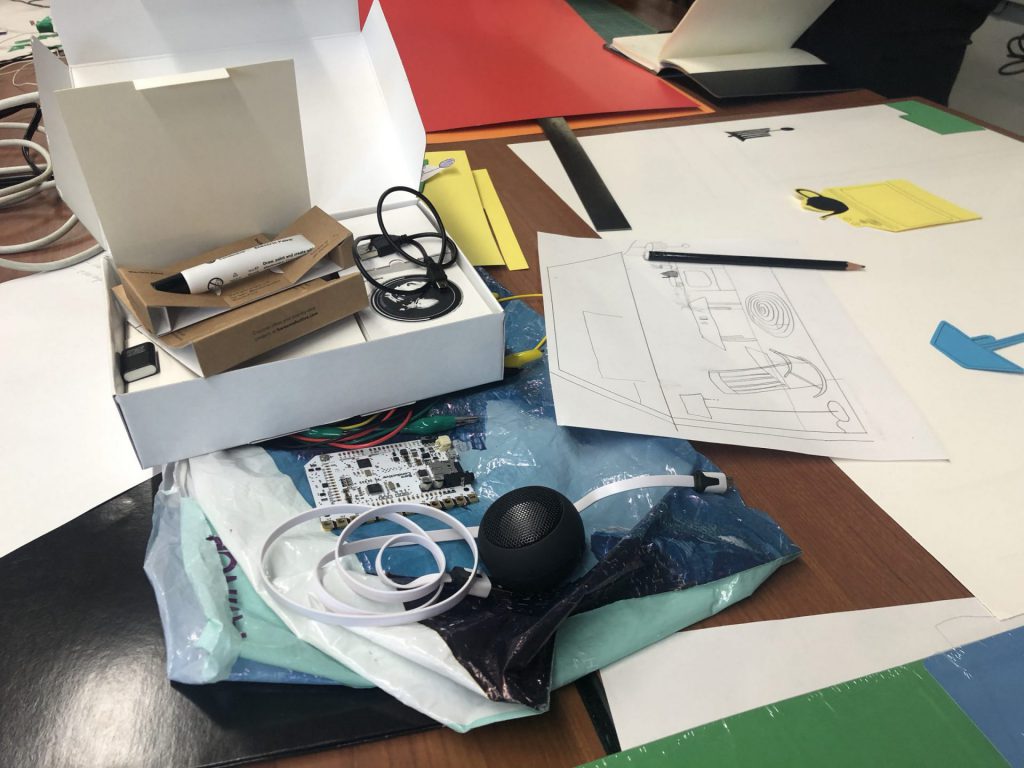
Aboriginal Territories in Cyberspace (AbTeC) and the Initiative for Indigenous Futures (IIF) are always looking to tell Indigneous stories in new ways. On November 28-29, IIF co-investigator Jane Tingley visited us at AbTeC/IIF headquarters to lead a workshop on the Bare Conductive Touch Board alongside Skawennati in the Milieux Makerspace. Workshop participants included Anastasia, Maize, and Waylon representing AbTeC and IIF, as well as Indigenous students Caitlin Court, Rachel Neufeld, and Sydney Hannusch from the University of Waterloo. Logan MacDonald, Assistant Professor of Indigenous Arts at UofW, also joined us. The Touch Board is an Arduino-powered interactive microcontroller programmed to play MP3 audio files when its sensors are touched. Depending on what sounds are loaded onto the Touch Board and how it is configured, this microcontroller can be used to create interactive art, MIDI instruments, and more that responds to human touch!
Day 1
The first day of the workshop began with group introductions and a collective recitation of the Ohén:ton Kariwatékwen (Thanksgiving Address). We then had a short presentation from Skawennati and myself on AbTeC, IIF, and the Skins Workshops on Aboriginal Storytelling and Digital Media. We explained how the majority of the Skins workshops require powerful computers for videogame or machinima production and that developing a new workshop focusing on storytelling through hardware hacking with the Touch Board might strike the perfect balance between high and low-tech workshop options.
After the preface, Jane took the floor and introduced everyone to the Touch Board. She explained the microcontroller’s components, how it processes interactions through either touch or proximity sensing, and the various methods of how to make touch and proximity points. This introduction concluded with a quick prototyping session where the participants formed groups and made touch points using random conductive objects found around the Makerspace, including tools, plants and even an apple! Everyone downloaded custom sounds from the web, like memes or animal noises, and converted them to MP3 files that were then copied to the board’s microSD card.
Jane continued her presentation in the afternoon by discussing the other functions of the Touch Board. Because the Touch Board is also an Arduino, users have access to a worldwide community of developers who freely share their open-source code. Everyone downloaded Arduino and swapped their Board’s default touch code for proximity code and retested the morning’s creations. Participants simply had to bring our hands close to the conductive point for the board to register sensor input. Just like magic! Proximity sensing is perfect for projects that use non-conductive materials for their interfaces. Conductive points can be hidden by non-conductive materials and still provide the same touch effect using proximity sensing.
After the presentation and testing concluded, the group move into a discussion on the possible ways that this technology might be used for Indigenous storytelling. Interactivity through sensing physical touch is the key to why the Touch Board is so unique. This feature can give users experiences that other forms of passive media cannot. Seeing as we had three boards, we brainstormed three different types of projects to try: an interactive dollhouse, a new musical instrument, and a technology from the future. Participants broke off into three groups based on their interest in each project and began designing and building their interactive art pieces for the remainder of the first day.
Day 2
Work time! After a short check-in, the groups formed the previous day reconvened and dove back into their work right where they left off. Everyone was so engaged they worked right through their scheduled breaks!
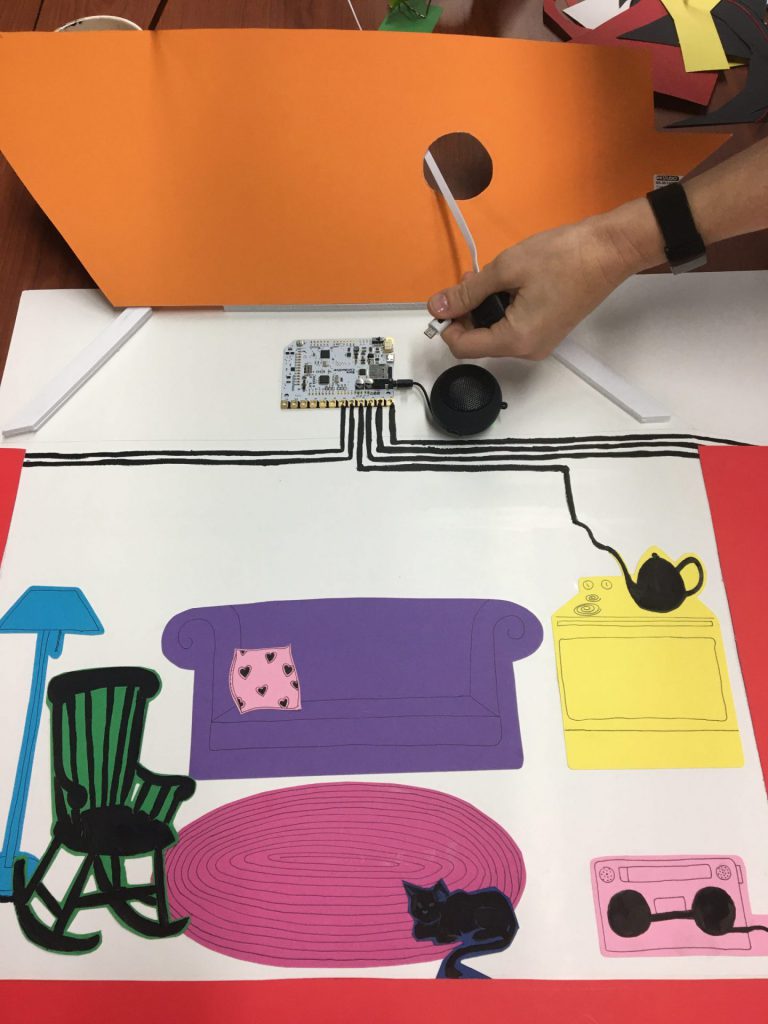
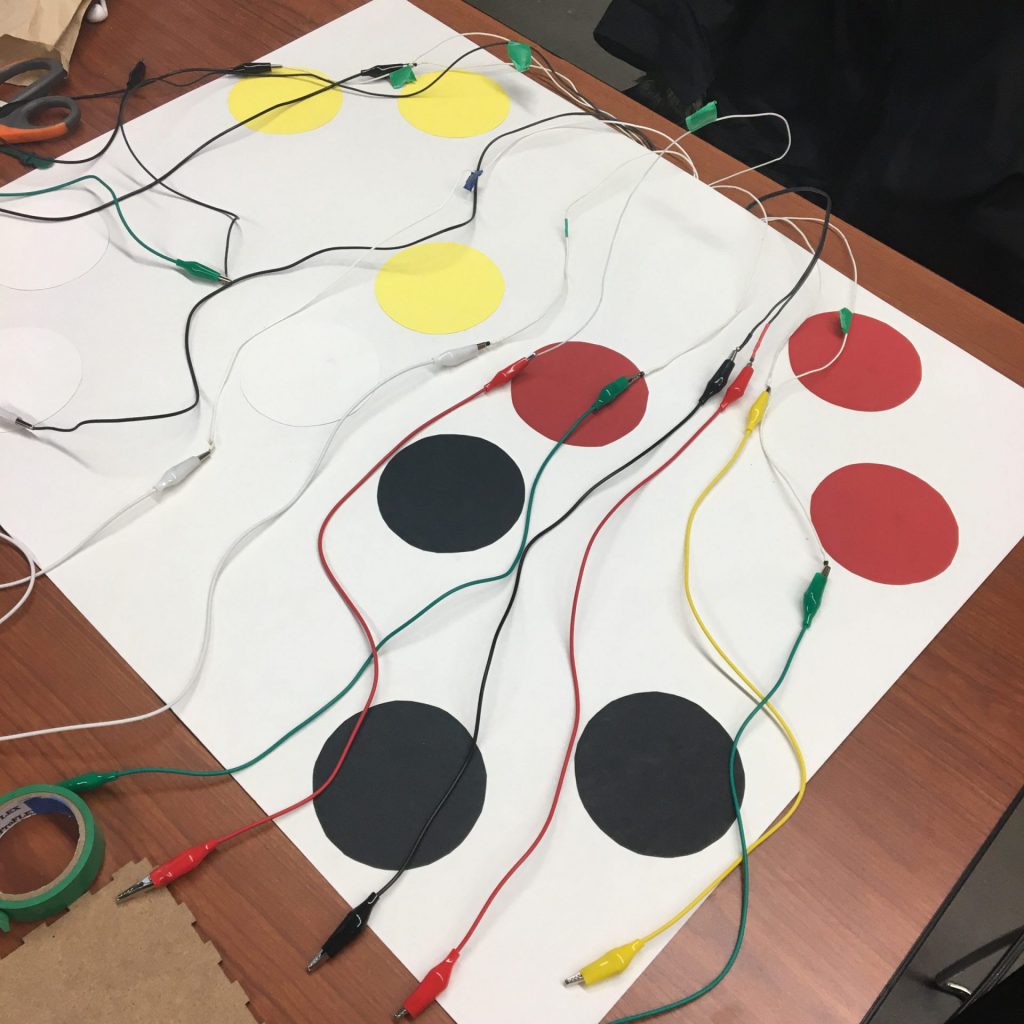
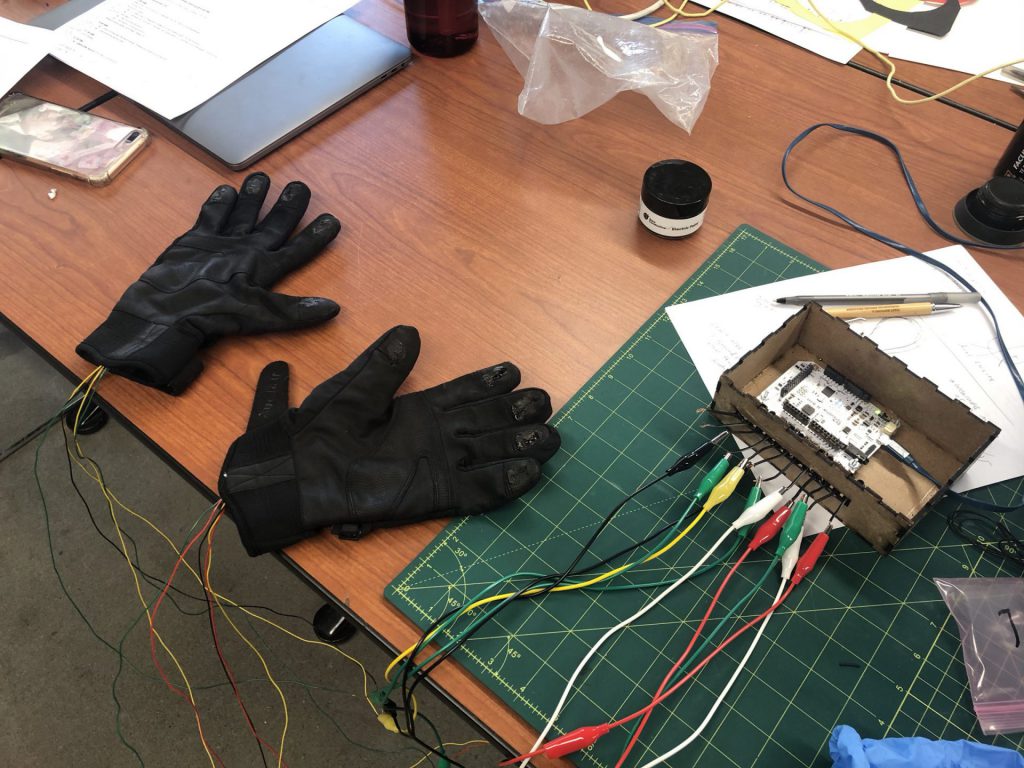
By late-afternoon each group had something to share. Everyone crowded around to view the live demonstrations, swapping places to test the interactive pieces.
Project 1: Tóta’s Dollhouse
Touch
Project 2: Drum Circle Instrument
Proximity / MIDI
Project 3: Communication Device of the Future
Touch
Thank you to the instructors and participants that made this workshop such a success!
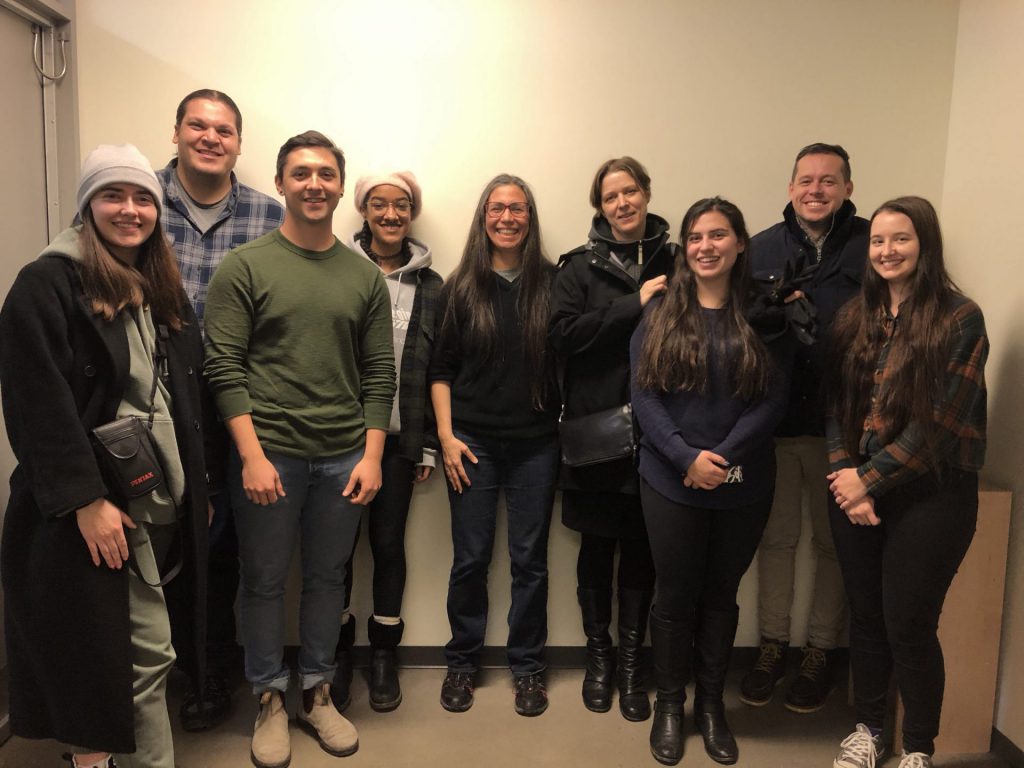
AbTeC RA RE-CAP: imagineNATIVE 20
AbTeC RA RE-CAP: imagineNATIVE 20
by IIF
December 12, 2019
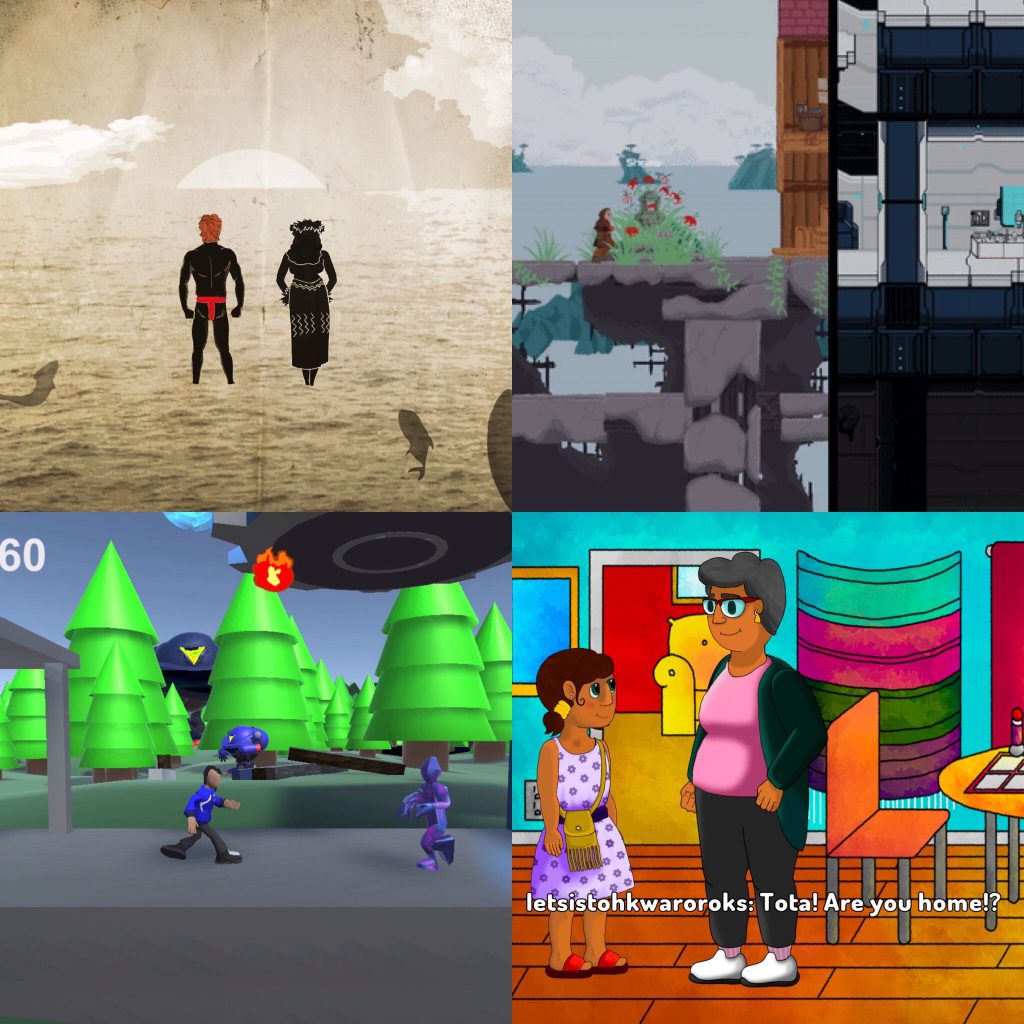
imagineNATIVE 20 Re-cap by Maize Longboat, Associate Director of Skins Workshops on Aboriginal Storytelling and Digital Media.
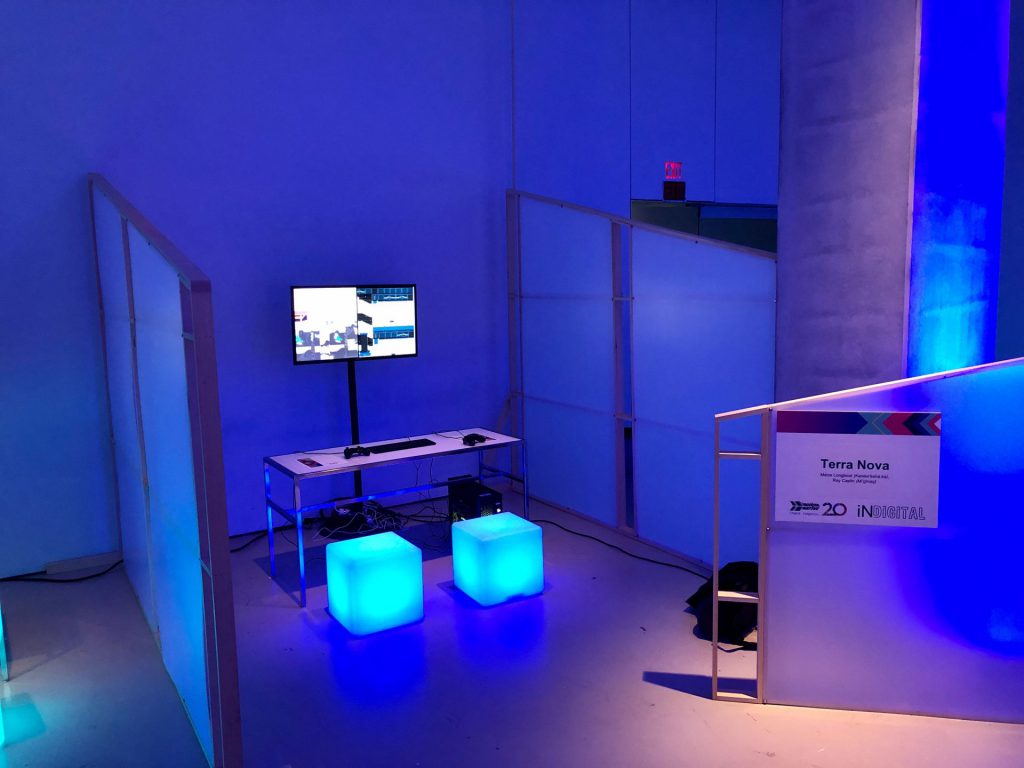
Late-October is a special time for Indigenous artists. imagineNATIVE is the world’s largest Indigenous film and digital media festival that honours the work of creative Natives from around the globe. This year, the festival celebrated its 20th anniversary and did so in style by revamping its digital media programming and the iNDigital Space. The iNDigital Space featured an impressive roster of video games, apps, audio works, 360-degree videos, and virtual reality experiences. I was honoured to show my first gameTerra Nova, alongside so many incredibly talented digital media makers in such a beautiful space.
Video Game Events
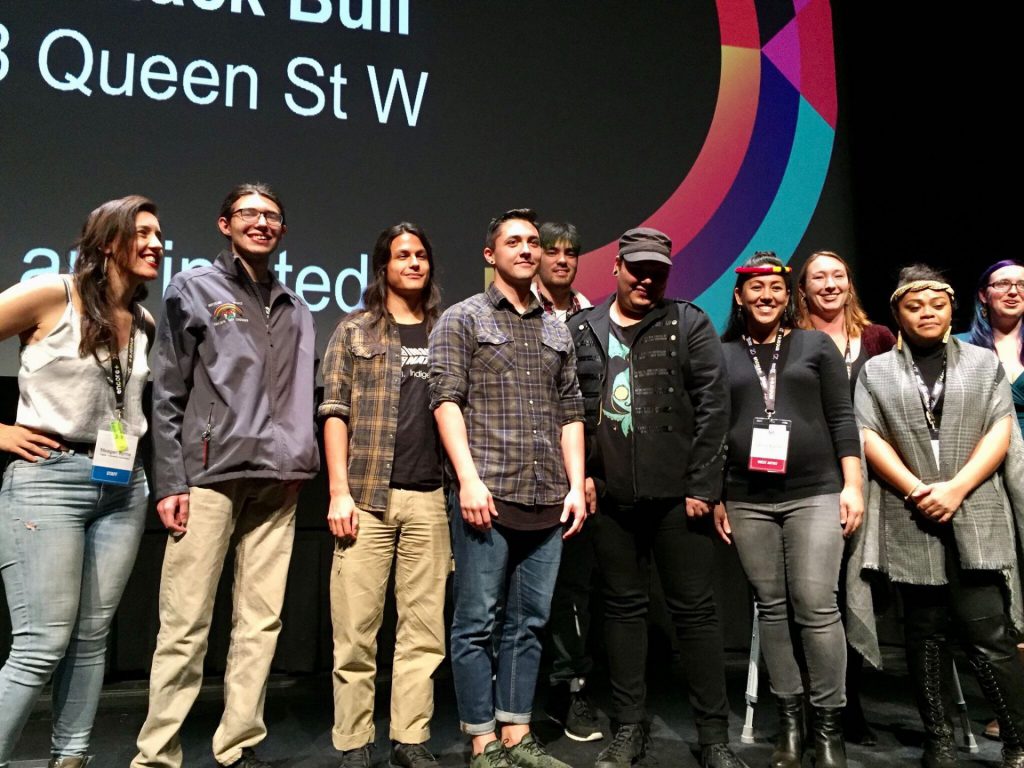
Several artist talks took place during the week and were moderated by Meagan Byrne imagineNATIVE’s Digital + Interactive Coordinator. I participated in the Video Game Artist Talk representing Terra Nova alongside the game’s Artist and Animator, Ray Caplin. The talk was a great opportunity to hear fellow game developers present their exciting work and to engage with an audience interested in the behind-the-scenes processes of game-making.
On Friday evening Meagan hosted‘Night of the Indigenous Devs;’ a live game-playing event that presented six games from the iNDigital Space onto the big screen. Both myself and Ray presented Terra Nova while keen volunteers played. The event offered a means for contextualizing and reflecting on the development process though dialogue with the audience. I really appreciated having the opportunity to share Terra Nova in a unique way that was just as dynamic and engaging for the audience as it was for the players.
Awards Ceremony

The festival wrapped up with an awards ceremony hosted by the hilarious Anishinaabe comedian and podcaster Ryan McMahon. To my surprise, Terra Nova was selected as the winner for the “Best Emerging Digital or Interactive Work” award among several impressive competitors! To top it all off, one of my idols, Anthony Makokis—who won this year’s season of The Amazing Race Canada with their partner James Makokis—presented the award! I have nothing but gratitude for everyone who supported the project throughout. I owe so much to the Terra Nova team, including Ray Caplin, Mehrdad Dehdashti, and Beatrix Moersch—without them the game would not have been possible to make. Niawen’kó:wa for this incredible honour!

3D Printed Inspirations by Waylon Wilson, Research Assistant for AbTeC/IIF.
‘Gathering Across Moana’ curated by GLAM with Noor Bhangu at the 20th imagineNATIVE Film and Media Arts Festival, at 401 Richmond Street, Toronto, Ontario.
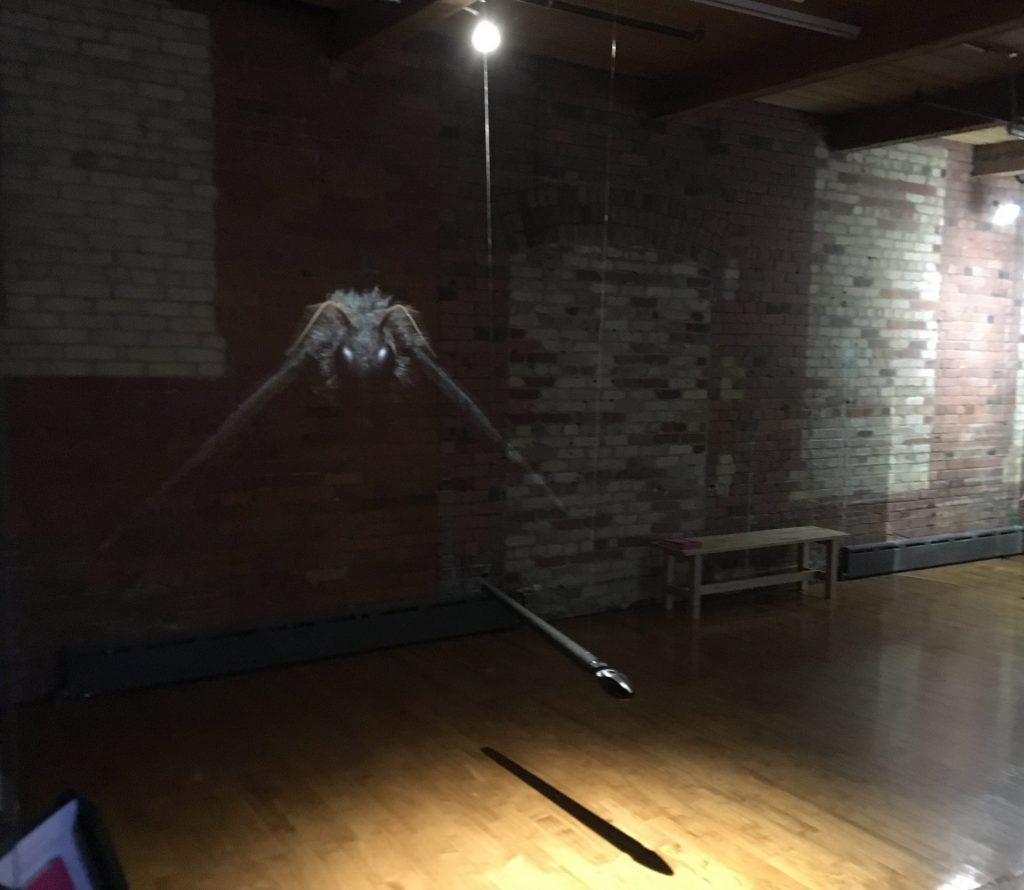
Each year the annual Indigenous film and media arts festival ImagineNATIVE hosts an art crawl where festival goers can visit a series of art exhibitions curated by Indigenous people. During this tour I came across The Sounds of Our Ancestors, 2018 by Kereama Taepa, this artwork really stood out to me as a media-maker engaging with new technology.
In this work a looping video projection shows a front-facing view of a bee flapping its wings. Electronic sounds of high pitched motors and beeps can be heard overhead. Hanging from the ceiling in front of the projector is a 3D printed object detailed with iconic depictions of Maori culture.
When I first approached The Sounds of Our Ancestors I thought the sounds I heard were coming from a common table-top scanner. Upon looking closer I realized the hanging object had been 3D printed, I began to recognize the audio to be the sound of a 3D printer. A 3D printer works by placing thin layers of plastic on top of each other, while the process occurs you can hear the buzzing of the tiny motors inside the machine. Taepa compares the buzzing of a 3D printer working in real-time, to the buzzing of bees.

I am familiar with some of Taepa’s previous work with 3D printing. Taepa talks about 3D printing as being a constructive process in which layers of plastic are added together in order to create an object. He contrasts this to carving, which is a deconstructive process where materials are taken away. He compares the constructive process of 3D printing to the process of a bee building its hive, it does so by adding layers, upon layers of material together over time.
I think Taepa’s work is a great example of how Indigenous perspectives bring new ideas into the digital world. For anyone interested in new ways of thinking about digital fabrication and Indigenous technological influences I highly recommend this artist’s work.
imagineNATIVE 20 Re-cap by Ray Caplin, Research Assistant for AbTeC/IIF.
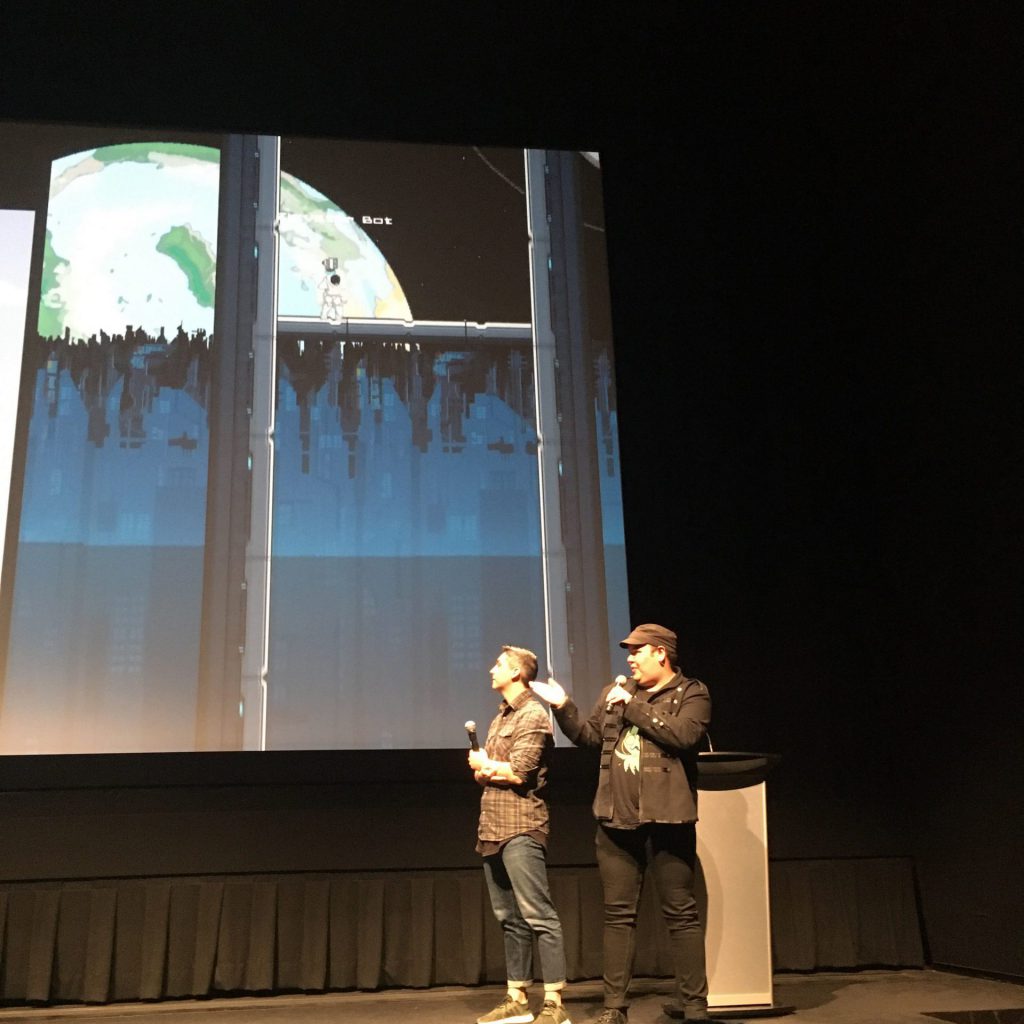
My experience at imagineNATIVE this year was mostly focused on video game and digital media workshops. I contributed to two video game projects which were featured inside of the iNDigital space. The iNDigital space was dedicated to showcasing video games created by Indigenous game developers. My work was featured in Wao Kanaka, and Terra Nova, I made art and animation for both games. I was very pleased to see both games in the iNDigal space, I feel each year this portion of imagineNATIVE is growing ever so slightly.
I also presented at ‘Night of Indigenous Devs’ which was an hour long panel and interactive discussion. Six Indigenous game developers presented their work on the big screen and volunteers from the audience played them. The response from the audience for Terra Nova was very positive and engaging. I found it very interesting to see how much emerging game related media was presented at this primarily film based festival.
imagineNATIVE 20 Re-cap by Kahentawaks Tiewishaw, Research Assistant for AbTeC/IIF.
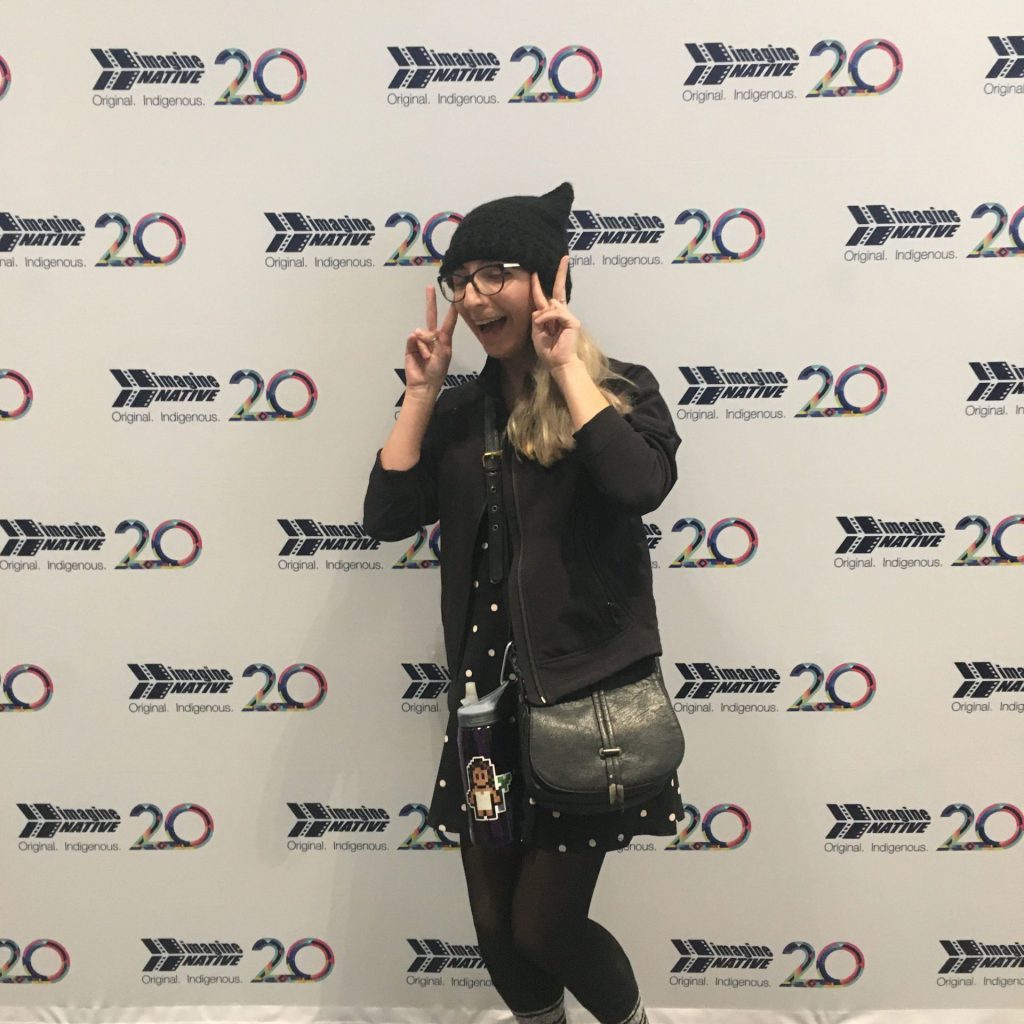
ImagineNATIVE was particularly awesome this year because it was my first time attending as a Guest Artist! Being able to be there as both a Research Assistant, and an independent creator was a remarkable experience. Not only could I take pride in the work I had done on Karihonniennihtshera, I was also able to bask in the fact that I was one of many AbTeC/IIF members who had work showing at the festival! You hear little bits about what everyone is working on all the time, so it was pretty amazing to see the end results as a part of the same exhibition. That was probably the best part of the festival for me. I can’t wait to see what we all do moving forward!
imagineNATIVE Festival 2019 by Anastasia Erickson, Research Coordinator for AbTeC/IIF.
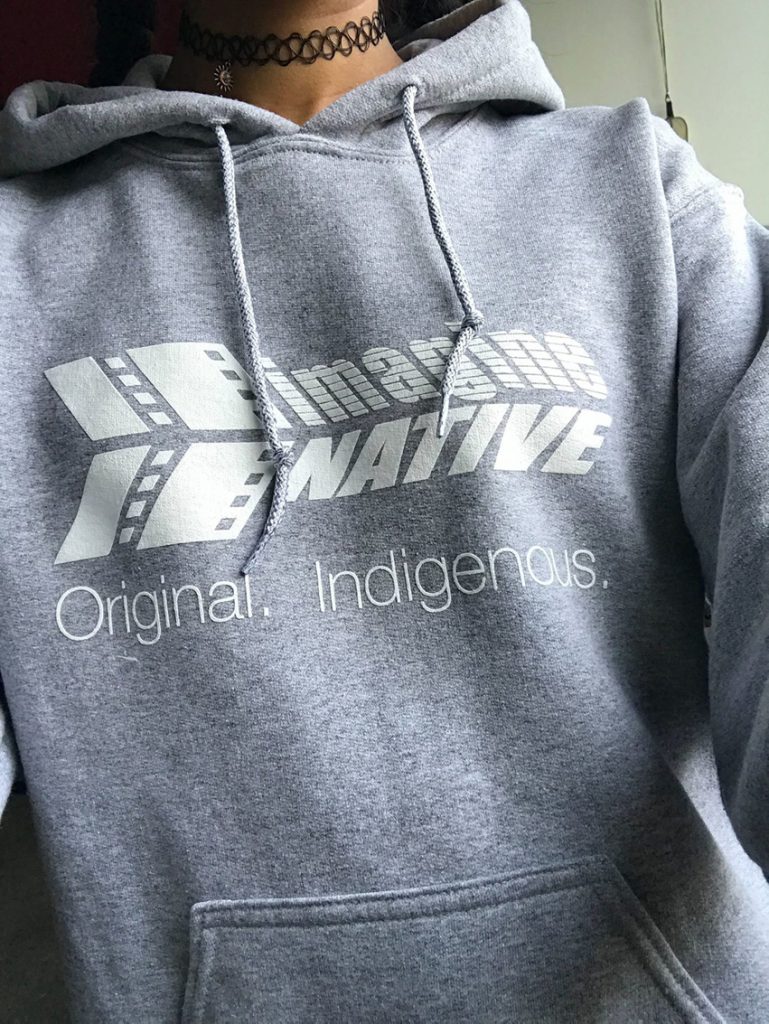
For one week each autumn, the TIFF Lightbox transforms into a space that welcomes filmmakers, digital media creators, and media enthusiasts for the imagineNATIVE Film + Media Arts Festival. This October, I was lucky enough to attend for the first time.
While the entire week was a whirlwind of fantastic art, fruitful new connections, inclusivity, and learning, what stood out to me the most was the feeling I had during and after the screening of one film in particular, Vai. Truly a tour de force, Vai is a feature-length film directed by eight different women from various Pacific cultures, following the life of one woman from early childhood through her life and into her elder years. Beautifully shot, the film was well-paced and engaging, and the use of eight distinct actresses in the portrayal of one character allowed for the audience to envision themselves in the narrative.
I watched this in the company of two female friends, and we each were in tears by the time the end credits began. It was a moving, empowering piece of art, and it made us feel proud to be strong women; yet, while it was a treasure to experience, it was simultaneously painful to process. I do not identify as being Indigenous to anywhere, as a biracial and diasporic Black American. My own heritage has been lost for a number of reasons, but most especially due to colonial violence and neglect; to be able to reflect on this melancholy during and after Vai was precious and important to me. There has always been a yearning to connect to the root of my root, to understand the cultures which my ancestors participated in and contributed to. Thus it was such a tender and bittersweet thing to bear witness to the passing down of long-held traditions through generations of Pacific women. Scenes of coming of age ceremonies and of communal customs are powerful images of resilience and kinship!
Though I may not have the same access to my roots as Vai’s filmmakers, it was still magical to be surrounded by a welcoming and diverse Indigenous community at the festival.
Underneath the Danglers by Alaina Perez, Research Assistant for AbTeC/IIF.
The imagineNATIVE Film + Digital Arts Festival celebrated its 20th anniversary this year in Toronto, Ontario. This was my first time attending and I was struck by the volume of festival programming that was organized. One of the events I was most looking forward to was the art crawl. I was eager to familiarize myself with the various installations exhibited in the 401 Richmond Building.
One exhibition I was particularly interested in was curated by DAPHNE, members including Skawennati, Hannah Claus, Nadia Myre and Caroline Monnet, all incredible Indigenous women artists I admire. DAPHNE curated ‘Constructive Interference’ an exhibition by Wendat artist Ludovic Boney. Having only seen the promotional image included in the event details, I was curious to see what other artwork would be accompanying the polychromatic danglers that were so pleasantly suspended from the ceiling.
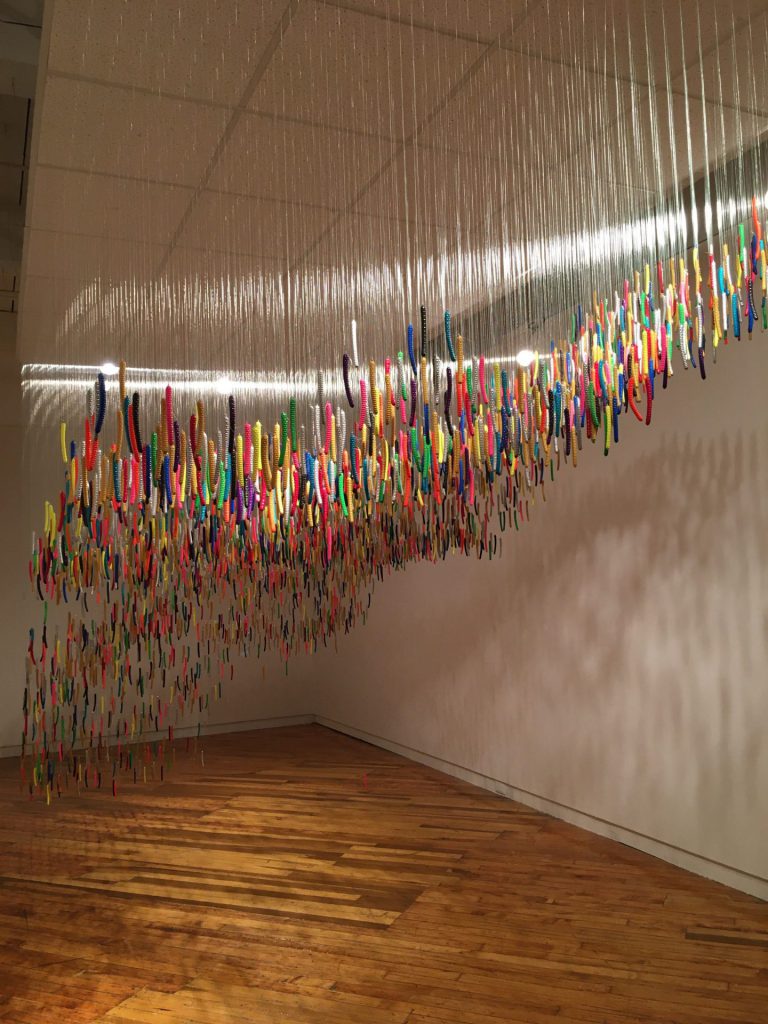
When I popped into the DAPHNE exhibit I was quite taken with Ludovic Boney’s Why So Many Ties? The presentation of the piece was straightforward, hundreds of metal sticks protruding from a wooden platform—each with a segment of a plastic shopping bag attached to it like a small flag. The wooden platform was destabilized making walking a bit precarious. The precarity of each step became even more exaggerated by the cacophony of creaks composed by Yannik Plamondon and Benoit Fortier which amplified every foot-forward by what seemed like 100 decibels.
I was anxious about my giant bag thwacking the sticks as I passed along the pathway. I was worried that I would damage the artwork, I was also a bit fixed on the very slight possibility of a stick hitting me in the face, (I am a humble 5’3.5, putting the sticks in a perfect eye-poking position). I loved how uncomfortable I was. I find visceral and affectual exhibition experiences to be a captivating strategy for engaging the viewer. I really enjoyed the uniqueness of this installation and after walking through the pathway I realized that the motion of my body left a reverberating effect on the sticks, they continued to sway long after my body passed. When looking at the swaying of the sticks I realized that their construction was intended to evoke the motion of bulrushes or similar brush.
When I revisited the exhibit during the art crawl artist Ludovik Boney was present and he discussed the installation. Hannah Claus asked about his choice of materials, particularly the bags, he responded in a completely unexpected way. I was expecting some sort of talk of environmentalism or something of a similar dimension. He explained that over the years every time he visits his mother she gives him food or some other item mothers give their children, and every time she does so she puts it in a plastic bag and double knots it. When Boney goes to open this gift from his mother he has to violently tear it open because the knots have been tied too tight. After many years of this he has ended up with a large collection of unusable plastic bags. He wasn’t sure what to do with them so he found a way to incorporate them into his art practice. I thought this was hilarious, seeing the extent of this collection of completely useless bags, I could feel the frustration of being in such a predicament. One would eventually have to adapt and learn how to use these collected ephemera in order to avoid their inconvenience. It was sweet to think about how Boney doesn’t want to tell his mother to change, choosing rather to adapt himself to her idiosyncrasies. It was charming to know that each of these sticks have manifested from a place of love and total frustration—a common phenomenon in many parent-child relationships.
Unboxing Skawennati’s Mannequin!
Unboxing Skawennati’s Mannequin!
by Dion Smith-Dokkie
June 20, 2019
Last week we unboxed a beautiful pink, pregnant mannequin! It was the latest installment of a project that began with the 2017 machinima, She Falls For Ages.
Throughout 2018, Skawennati worked with a team of AbTeC/IIF Research Assistants to create a cosplay version of Otsitsakaion—also known as Sky Woman—from She Falls for Ages. The 2017 machinima is a sci-fi retelling of the Haudenosaunee Creation Story, in which Sky Woman falls from Sky World and creates our world. In her recent work, Skawennati explores material practice in relation to its virtual counterparts—what does it mean to create physical objects that exist in digital worlds?
To delve into this research, she enlisted the help of Producer Nancy Elizabeth Townsend, and Research Assistants Suzanne Kite, Kahentawaks Tiewishaw, and Valerie Bourdon. At the Milieux Institute in the Textiles and Materiality Research Cluster‘s space, the team worked together weekly creating and modifying patterns, programming digital embroidery on the amazing Tajima machine, and developing hair and make-up. After months of prototyping and construction, Otsitsakaion’s dress was successfully transformed from the digital form into real life!
Undergraduate Research Assistant Kahentawaks Tiewishaw was the first to don the costume when she premiered it at the 2018 Indigenous Comic Con in Albuquerque, New Mexico!
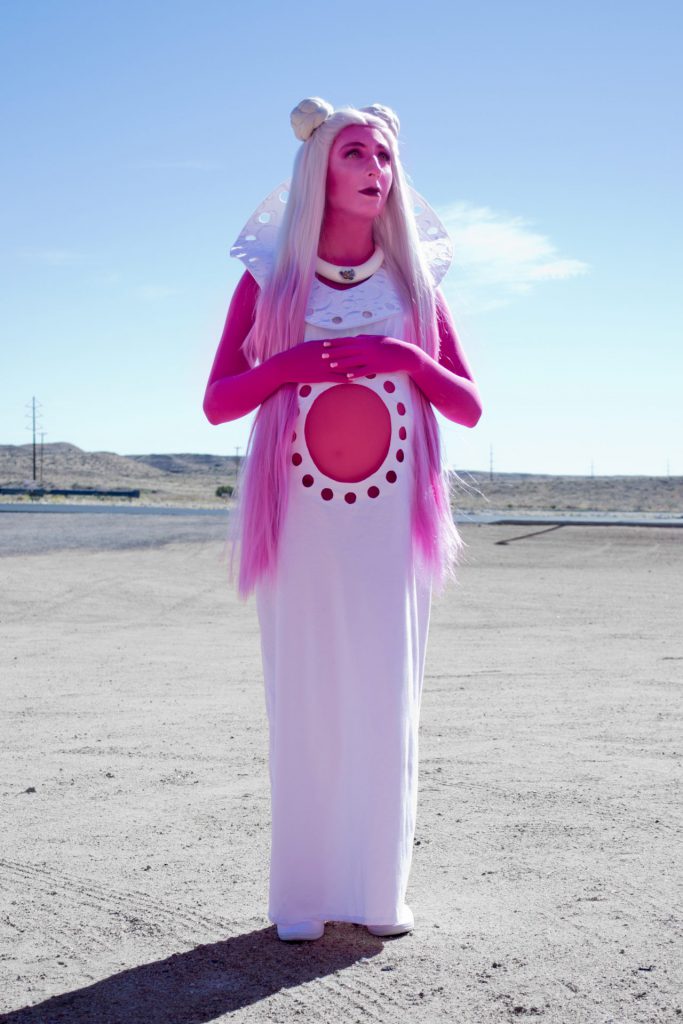
Since then, Skawennati has engaged IIF Artist-in-Residence Dayna Danger to photograph her wearing the Otsitsakaion costume for a project not unlike the 2015 Dancing With Herself, which first appeared in The Rebel Yells exhibition at the FOFA and later in Tomorrow People at OBORO.
The new mannequin was custom-ordered and took 14 weeks to get here—half of the time it takes a baby! Watch Skawennati and Nancy unbox it in this video.
You can watch the machinima, She Falls for Ages, on Skawennati’s website.
Teaching Indigenous Youth to Imagine and Create their Own Futuristic 3D Digital Environments
by Waylon Wilson
June 14, 2019
Here at the Initiative for Indigenous Futures (IIF) and Aboriginal Territories in Cyberspace (AbTeC), we are dedicated to Indigenous perspectives and imaginings of the future. In my research as a Master of Design student, I examine interactive practices of Indigenous peoples, especially of my own Tuscarora Nation. By developing a better understanding of the principles behind cultural practices, such as wampum belts and traditional games, we can better understand how to utilize modern technology as a tool in which we can embed our contemporary culturally perspectives for future generations. What I have observed is that visions of the future imaginary and alternative realities can be realized through numerous forms of media.
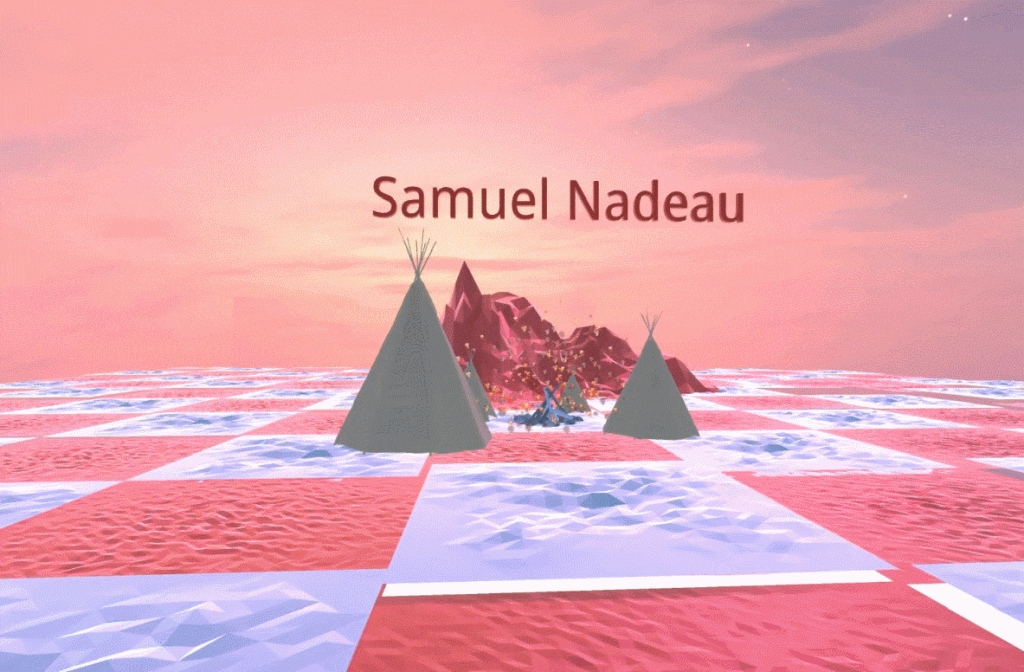
I recently represented AbTeC/IIF as an assistant instructor during a mini workshop series led by Stéphane Nepton and Andrea Gonzalez, co-founders of Uhu labos nomades. Uhu labos nomades is a non-profit that supports the perseverance and academic success of Indigenous Youth through digital arts immersion workshops and conferences; hosted both in schools and in community. Uhu places great importance on issues related to low retention rates, loss of identity, and sustaining cultural health. They focus on the enhancement, dissemination, and transmission of Aboriginal culture through digital arts, which is for them an essential bridge between elders and the current generation.
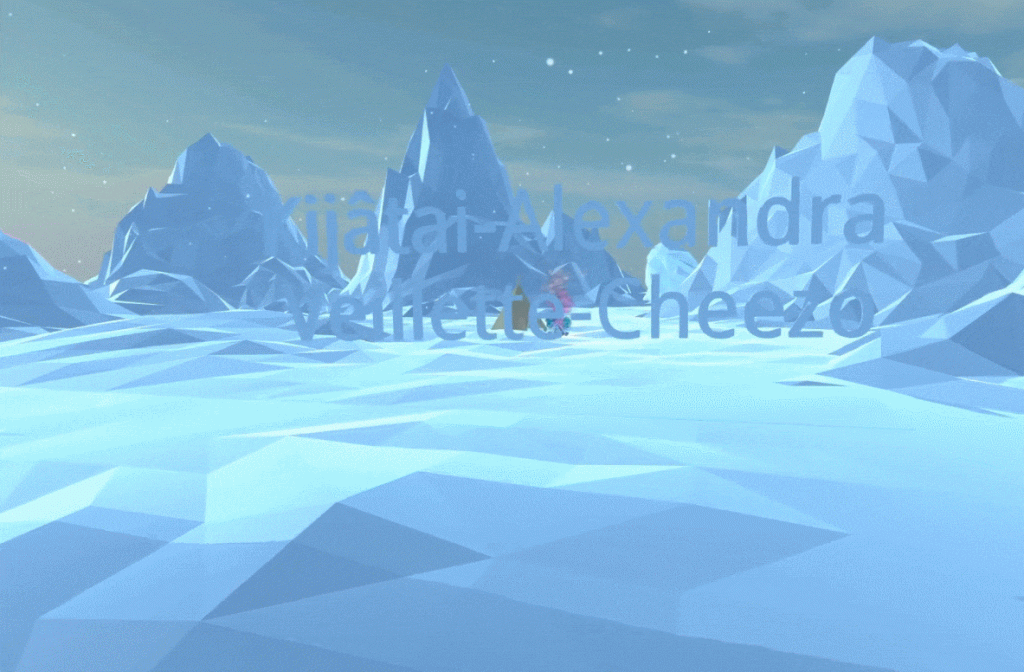
Uhu collaborated with Native Montreal and Concordia’s Office of Community Engagement (OCE) to assemble a 4-part workshop series that introduced Indigenous Youth to the process of imagining and creating their own 3D environments, complete with visual effects such as weather. Uhu, with the help of the OCE, reached out to us about the workshops. There were eight Youth who participated in the workshops of varying backgrounds with little to no experience in digital media creation. Specials guests, Jason Edward Lewis and Skawennati, co-founders and co-directors of AbTeC and IIF, greeted the participants one day and provided a tour of IIF’s creative headquarters. This was an exciting opportunity for participants to see where we build our digital imaginings, experience one-on-one time to ask questions about our creative process, and gain some insight into the collaborative environment of Indigenous future-making. With Stéphane’s instruction, participants took a hands-on approach to creating a world of their own imagining with virtual 3D tools.
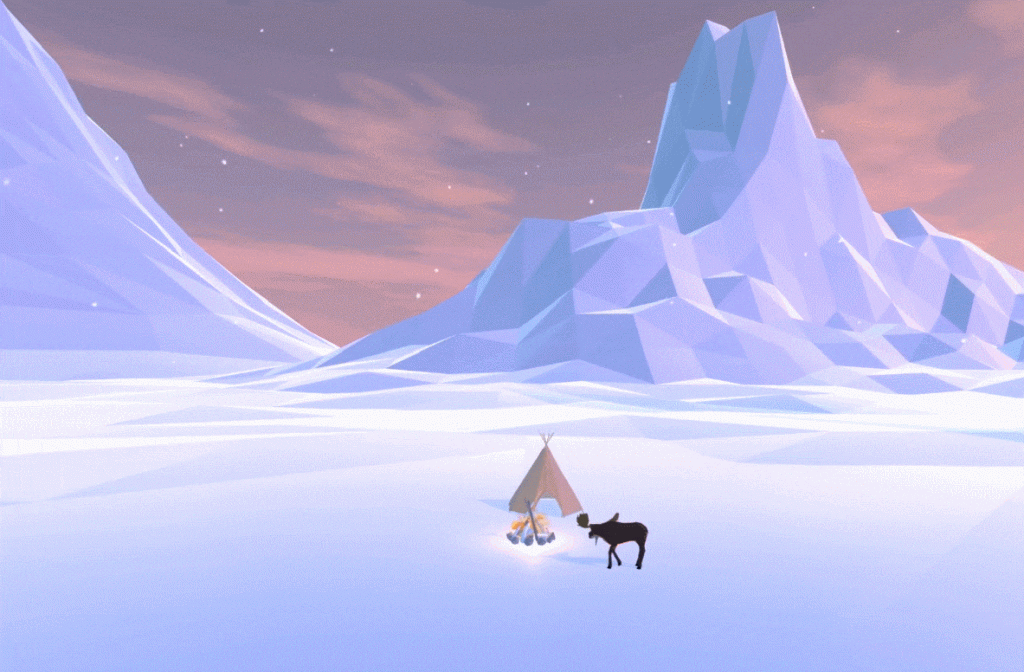
When the time came for the first workshop, Mother Nature had imagined her own visual effects and sent a radical blizzard to welcome each of us! However, the storm didn’t stop our dedicated participants! Eager to dive into some digital-3D fun, several participants arrived, including two who came all the way from Quebec City! Stéphane, a professional visual effects artist, demonstrated the creative and persuasive abilities that visual effects could have in a viewer’s experience with digital works of art. Visual effects are illusions and manipulated imagery that have been added to a videogame’s gameplay that give the gamer a more life-like or immersed experience. Examples of common visual effects in games are animated elements such as smoke, fire, rain, fog, or any kind particle emissions such as sparks and fireworks. Stéphane demonstrated that visual effects can in fact be a self-standing work of art.
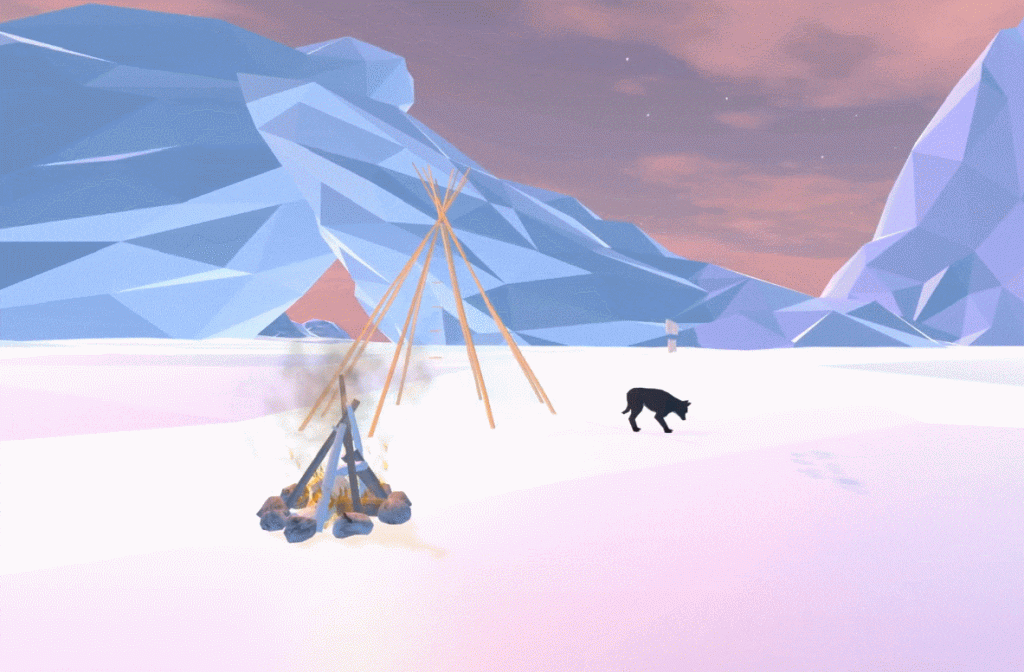
Participants learned how to use free gaming engines to create digital 3D worlds as a form of expressing oneself in a virtual environment. Using premade 3D models such as mountain faces, rocky terrains, and other earth textures—provided by Stéphane—students assembled landscapes of their own desire and imagining. Students who had next to no experience in using computer programs gained competencies; by the end of this series, they had no problem performing basic 3D building tasks and creating special effects.
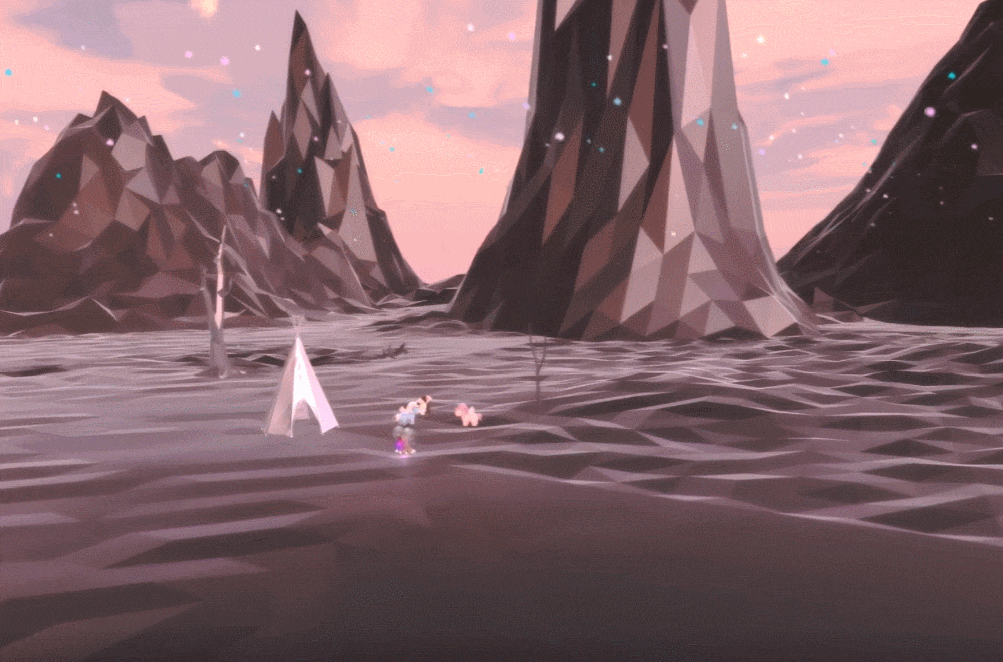
Once the students had learned how to create a basic 3D environment, they were then introduced to how to simulate weather, fire, snow, rain, and wind. Stéphane walked participants through customizing 3D effects tools to realize the designs they had in mind. The results resembled futuristic depictions of landscapes typically associated with Indigenous nations in the Great Plains such as teepee villages; these designs juxtaposed themes of old and new knowledge and practices within a single environment. Students shaped their landscapes to imagine environments with unique narratives, what feel like multiple visions of alternative realities.
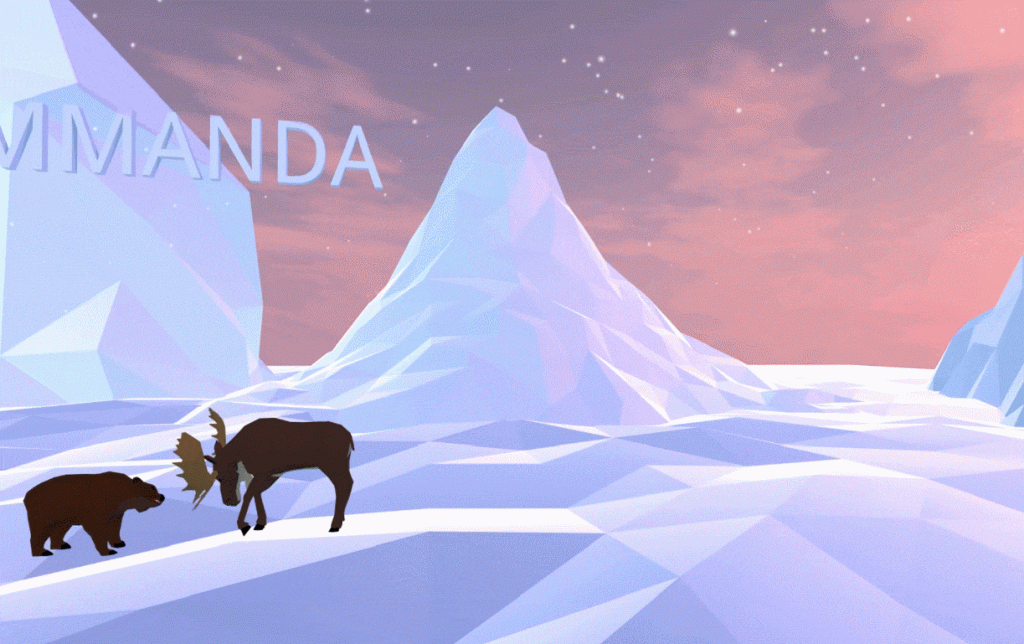
In the end, participants had an exciting time expressing themselves through these 3D digital tools, and some even informed us that they had downloaded the software to carry on their work at home, developing their environment and imagining new ones! Native Montreal and Uhu labos nomades hosted a brief awards event to showcase the students’ work and to recognize the unique qualities each student displayed in the workshops. Attendees could experience the worlds through a virtual reality headset; this gave both the creators and audience an entirely new, life-like encounter with the artworks.
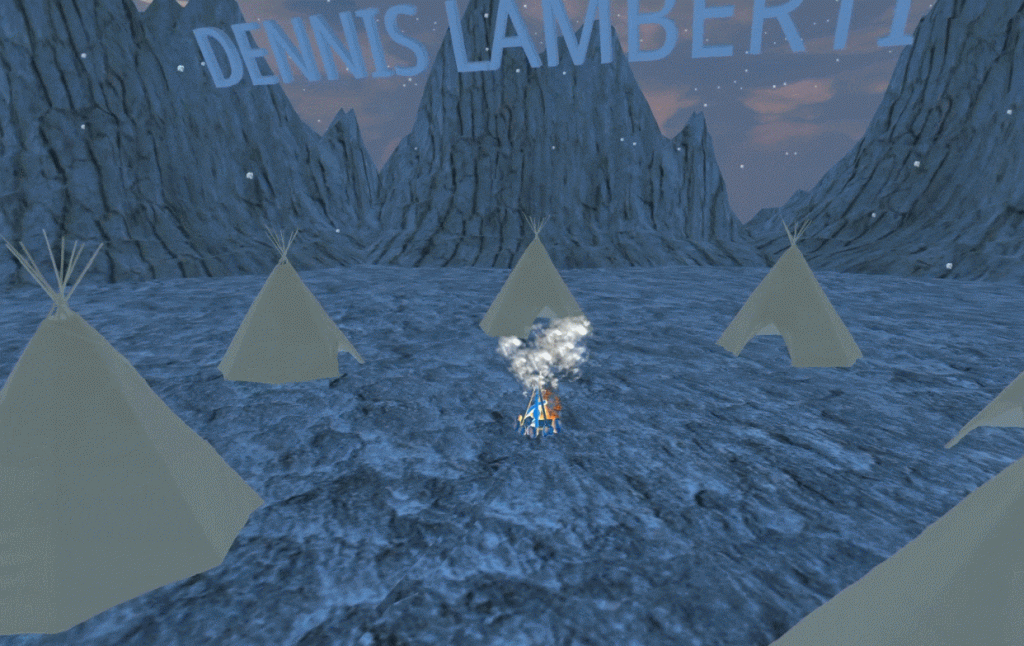
For my part, it was exciting to be part of the students’ digital environments and the environment of the classroom and maker-setting. The collaborative makerspace that we shared as learners and media makers reflected how AbTeC and IIF create camaraderie and support in imagining futures together as Indigenous peoples. Being part of this experience, sharing these digital tools while empowering each other to imagine and create futuristic digital environments, serves as a good reminder to imagine and create our own Indigenous futures here in the real world.
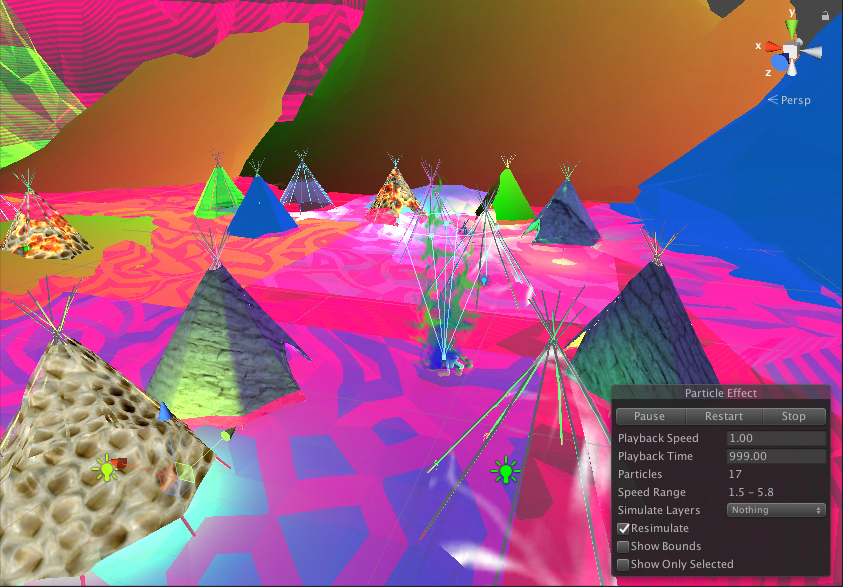
Recording Indigenous New Media History on Wikipedia
by Sara England
April 26, 2019
On Thursday, March 14th, Indigenous Futures Cluster presented our first-ever Wikipedia Edit-a-thon! The event was hosted at Milieux Institute for Arts, Culture and Technology and supported by Art + Feminism and Wikimedia Canada.
The Indigenous Futures Cluster Wikipedia Edit-a-thon focused on the improvement and creation of Wikipedia content about Indigenous new media artists in North America and the Pacific. We provided tutorials for beginner Wikipedians, supported and researched materials for editing Wikipedia articles and, in particular, built capacity for Indigenous participants to manage and determine how their cultures and communities are represented in cyberspace.
Why an Edit-a-thon?
Wikipedia is an online encyclopedia populated by users (usually on a volunteer basis) who edit and generate its content. Anyone can become a Wikipedia editor–you just need a username and password—and can add, change or remove content to an existing article or create a new article from scratch. It can be a wonderful platform to promote knowledge-sharing, empower people to participate in knowledge-making and open access to information.
However, the content on Wikipedia reflects the interests of its users—a demographic of mostly white, English-speaking men in North America. According to Wikipedia’s Writing About Women page, as of 2016, only 8.5 to 16.1 percent of editors on English Wikipedia are women. This underrepresentation of women, people of colour, Indigenous peoples, and LGBTQ+ identified in the makeup of Wikipedia’s editors skews the platform’s content and reflects existing social biases. (For more on this see Wikipedia’s pages on racial bias and gender bias. Wikipedia’s Racial bias on Wikipedia page acknowledges the lack of Black history on Wikipedia due to articles predominantly being written by white editors.)
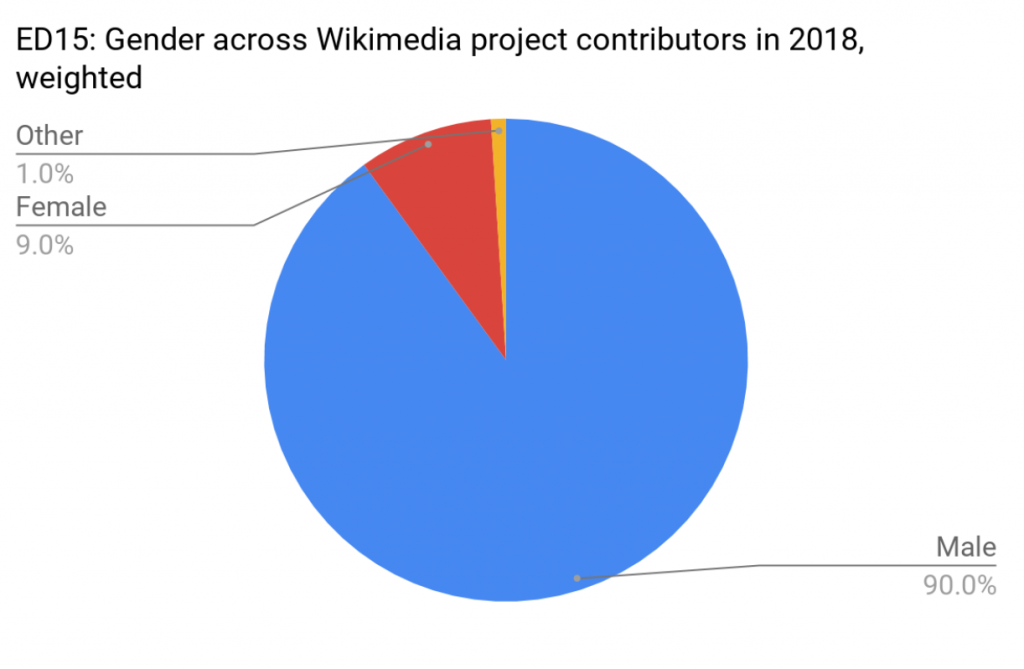
We organized the Wikipedia Edit-a-thon knowing that Wikipedia lacked both content about Indigenous cultures and communities, and content written by Indigenous editors. We wanted to contribute to rectifying that by recruiting Indigenous people and allies to become Wikipedia editors and use the platform to support Indigenous cultures and communities through knowledge-sharing and -creation.
Why address Indigenous New Media History?
As a research cluster dedicated to Indigenous digital media research-creation, we know that the rich history of Indigenous digital art practice has been poorly documented and largely ignored in art historical texts (though there are people working to resolve that!). Despite this historical absence, Indigenous artists have been at the forefront of experimentation and innovation in media and digital art practices for the past two decades. In Rudi Aker’s interview with the Kahnawake radio station K1037 about the edit-a-thon, she addressed this lack of documentation using the example of multidisciplinary artist Adrian Stimson, who was awarded the prestigious 2018 Governor General’s Award in Visual and Media Arts—he did not have a Wikipedia page! There are many examples of notable Indigenous artists working with digital technologies whose histories remain underrepresented and unacknowledged. We compiled a list of these artists and during the edit-a-thon, we updated their existing Wikipedia pages or created new ones!
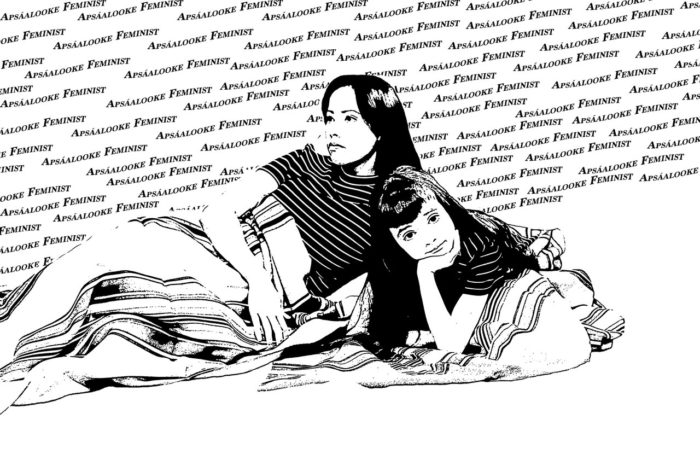
What did we do?
Amber Berson, ambassador for Art + Feminism and Wikimedia Canada, led a tutorial about how to edit in Wikipedia and helped us feel comfortable with the platform. Following Amber’s tutorial, Dr. Greg Younging, a member of the Opaskwayak Cree Nation in northern Manitoba and author of Elements of Indigenous Style: A Guide for Writing by and about Indigenous Peoples(2018), gave a Skype presentation about methods for writing about Indigenous peoples and cultures respectfully and appropriately. Dr. Younging’s book is the first style guide dedicated to Indigenous content for editors and publishers to use, alongside their chosen in-house style manuals, to responsibly publish Indigenous literature. After we were nourished and hydrated with some lunch, we applied Younging’s principles to our communal editing session!
Prior to the Edit-a-thon, Research Assistants Charissa Von Harringa and Rudi Aker identified some of the gaps in information about Indigenous new media artists on Wikipedia and compiled a list of articles for editing and creation. They also gathered resources from the web and pulled literature from AbTeC/IIF’s library to use for research. Our list of tasks was then added to our Event Dashboard for editors to browse and assign themselves projects. The Dashboard will remain active for a year so we can track our edits and continue to work as a group.
By the end of the day, we had made over 60 edits, edited 17 articles, and added 4,510 words to Wikipedia! Pages for artists including Raven Davis, Pia Arke and Amanda Strong were improved with more citations, copy edits, infoboxes, and lengthier edits such as the creation of new sections. A page was created for Cree and French Métis theorist, curator and artist Âhasiw Maskêgon-Iskwêw, one of the most prominent figures in Indigenous new media art. Now a record of his career exists on Wikipedia to help document his legacy.
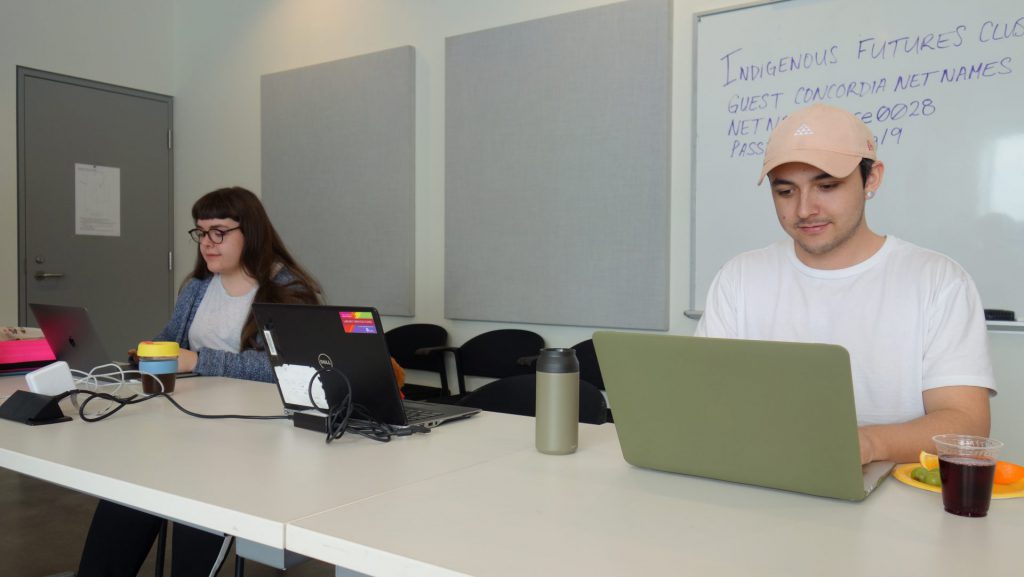
Ready to Edit?
Excited about our project and want to participate? Create a Wikipedia account, check out some online resources, join our Dashboard and start editing!
On Borinquén/Puerto Rico
On Borinquén/Puerto Rico
by Léuli Eshrāghi and Lucas LaRochelle
April 1, 2019
In February, Postdoctoral Fellow Léuli Eshrāghi and Undergraduate Research Assistant Lucas LaRochelle attended the Sites Queer: Technologies, Spaces, and Otherness conference in Borinquén (Puerto Rico) at the University of Puerto Rico.
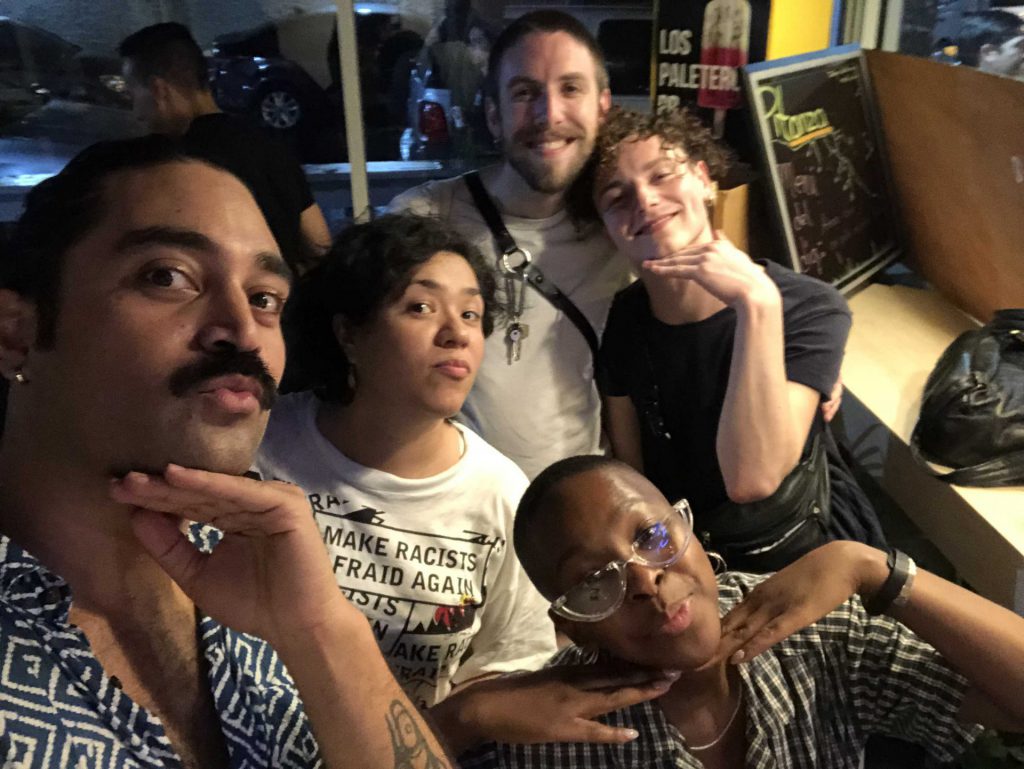
It was a gift to take part in the Sites Queer conference at the University of Puerto Rico – Río Piedras School of Architecture, organized by Dr. Regner Ramos.
The informal space around the panels and presentations yielded the most fruitful dialogue—in turn generating new, and likely longlasting, kinship networks. The house that we cohabitated became a site of queer kinship that wasn’t predicated on transactional sex but rather a space of mutual support, encouragement. I was especially grateful for this when the digital project I had come to present crashed unexpectedly as a result of receiving 3000 new submissions in a period of 6 hours. What would have otherwise resulted in a lonely anxiety spiral was softened by words of encouragement and the physical closeness of nènè and Léuli as we convened around the dining room table.

On the final day of the conference, nènè myriam konatè and I led our workshop Prototyping for Emergent Queer Spaces with a group of about 14 new kin from Borinquén/Puerto Rico, Tiohtià:ke/Montreal, Tkaronto/Toronto, Mannahatta/New York, Shawmut/Boston, Checaugou/Chicago and London. We began the workshop by collectively sharing stories of queer experience with particular attention to the role of place within these narratives. What was intended to be a one-hour storytelling session extended laterally into a three hour outpouring of queer feeling, traversing intergenerational care, non-sexual intimacies, family, death, racialization, diasporic identity, sexual harassment, transhumanist becoming, among other tentacles of experience. From here we moved into the prototyping session of our workshop, in which we reframed our stories through nènè’s yes and also… methodology, which encourages us to come to new understandings of our self-concepts by replacing negations with affirmations. Drawing from our reframed personal narratives, we prototyped speculative queer futures composited from our experiences of joy, pain and resistance.
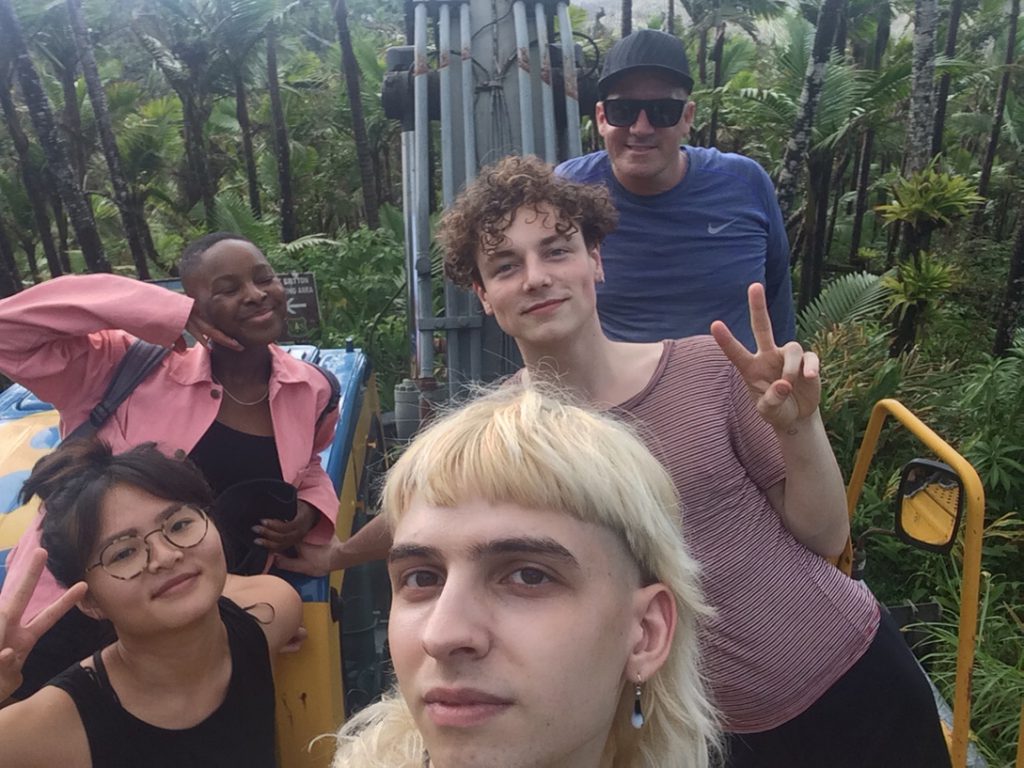
Our final day in Borinquén/Puerto Rico was spent at El Yunque, a rainforest in the northeast of the island. Jason Baerg shared with us the proper protocol to thank the Taíno, on whose territory we had stayed the past five days. We reflected on the imposition of the poured concrete path that structured our movement through the rainforest, and the ways in which it inhibited the kinds of relations were possible with all of the non-human life that enveloped us. That the concrete path functioned as an infrastructural tool that drew a harsh line between the human and the non-human – the rainforest as something to be looked at, consumed and contained rather than something to form an equitable relationship with. The colonial implications of these architectural interventions came into sharper focus upon seeing bright orange plastic barriers littered throughout El Yunque. Bearing the insignia of the US Forestry Department, the barriers route flows of human and non-human life and underscore Borinquén’s continued occupation by the American Empire.
Lucas LaRochelle
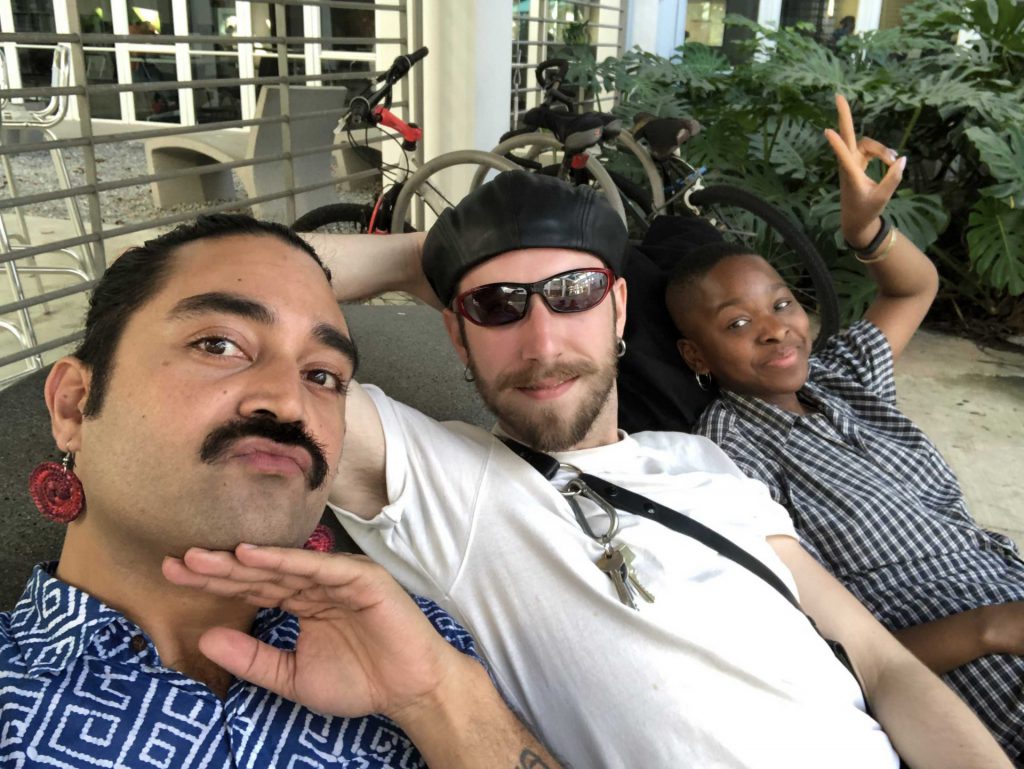
The specificities we were learning on each day of the conference about the colonization of Borinquén by the United States after Spain struck and stuck with us. On the periphery of the American Empire, the tropical heat was so familiar and encompassing whilst still a departure for our sensibilities from the winter wonderland of the Canadian Shield and its cities. Compellingly, the generosity between and beyond the two languages occupying space in the same place at the same time in the Sites Queer conference—Puertorriqueñx Spanish, American English—also enabled the francophone delegates to converse freely without the usual defensiveness of anglophones in Canadian contexts.
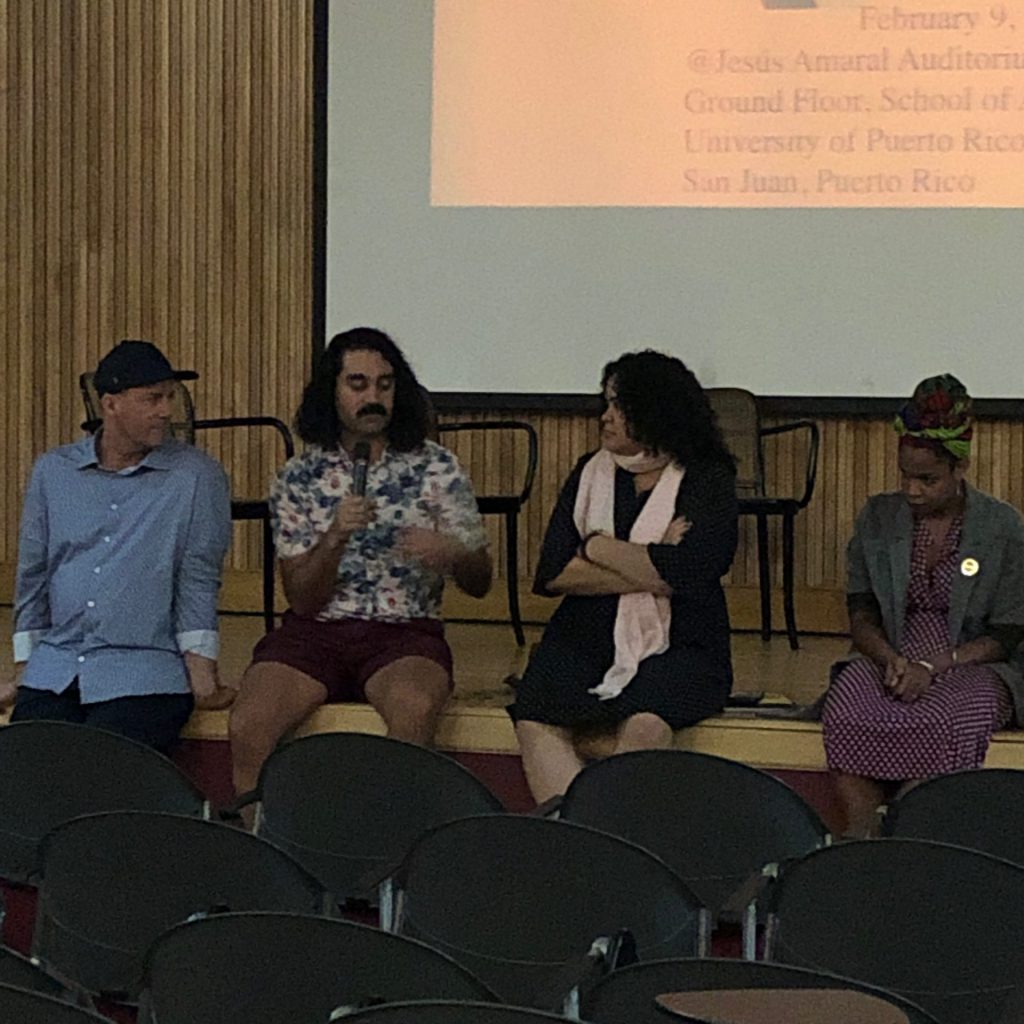
The parallels also between processes of recovery and resurgence in queer Indigenous practices, networks of care, histories embodied and enlivened within Jason Baerg and my own presentations—and nascent conversations and aesthetic interventions into Puertorriqueñx Indigeneity—were emotionally and spiritually important. The intervention into the Euro-American theoretical and historical dominance of capitalized Queer Theory and Queer Art History that networked global Indigenous artistic and curatorial practices bring into being was another welcome departure from United States-specific discourses. These fail to link Indigenous resurgence and peripheral American territories’ claims to self-determination as being interlinked with queer freedoms embodied and socialized. Indeed, the illegal overthrow of Queen Liliʻuokalani in the sovereign Hawaiian Kingdom in the 1893-1898 period and the seizing of Borinquén/Puerto Rico, Cuba and the Philippines from the Spanish Crown are integral points in the development of the armature of empire—this time a carceral settler-colonial state that punishes perceived deviance from Caucasian heteropatriarchal norms.
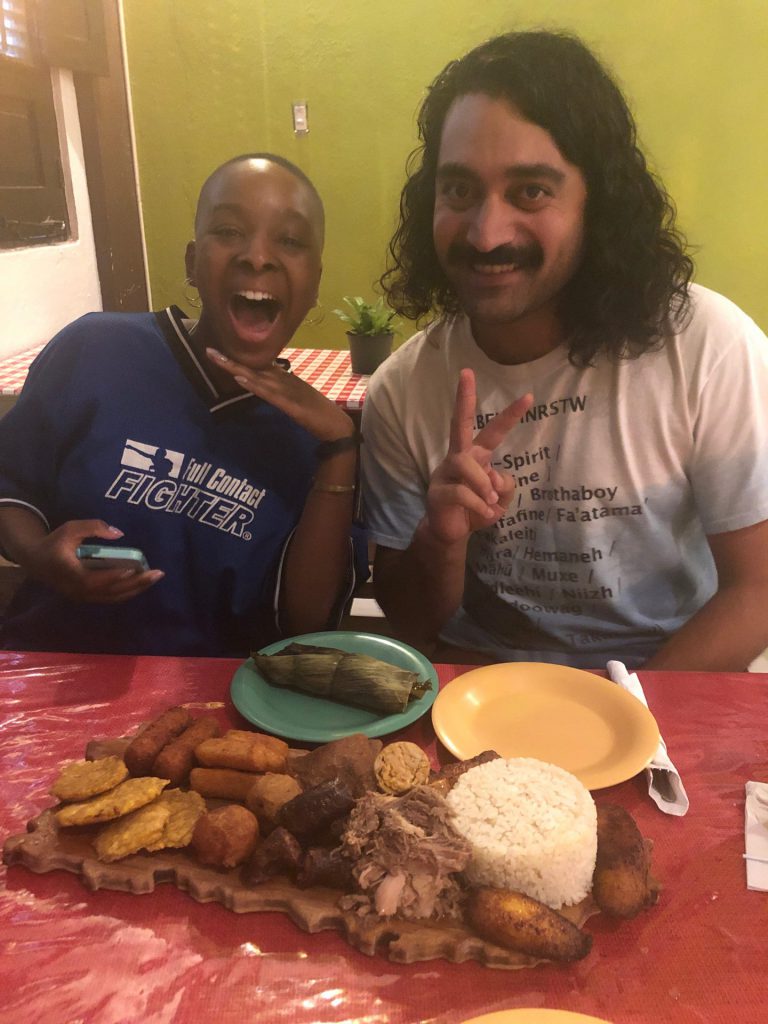
New sustained relationships with kin from near and far garnered through all our presentations, participation in the workshop, and hanging out—particularly the queer architectures exhibition opening on campus curated by convenor Dr. Regner Ramos, the Drag King night at a local queer bar, the unexpected gift of a free Princess Nokia concert in support of the brutalized local trans queer non-binary community following a savage murder weeks earlier, and time visiting in Old San Juan, the beach, and the forest in El Yunque proved this journey to be much more than salvatory, but a transformational experience. Muchísimas gracias a todxs.
Léuli Eshrāghi
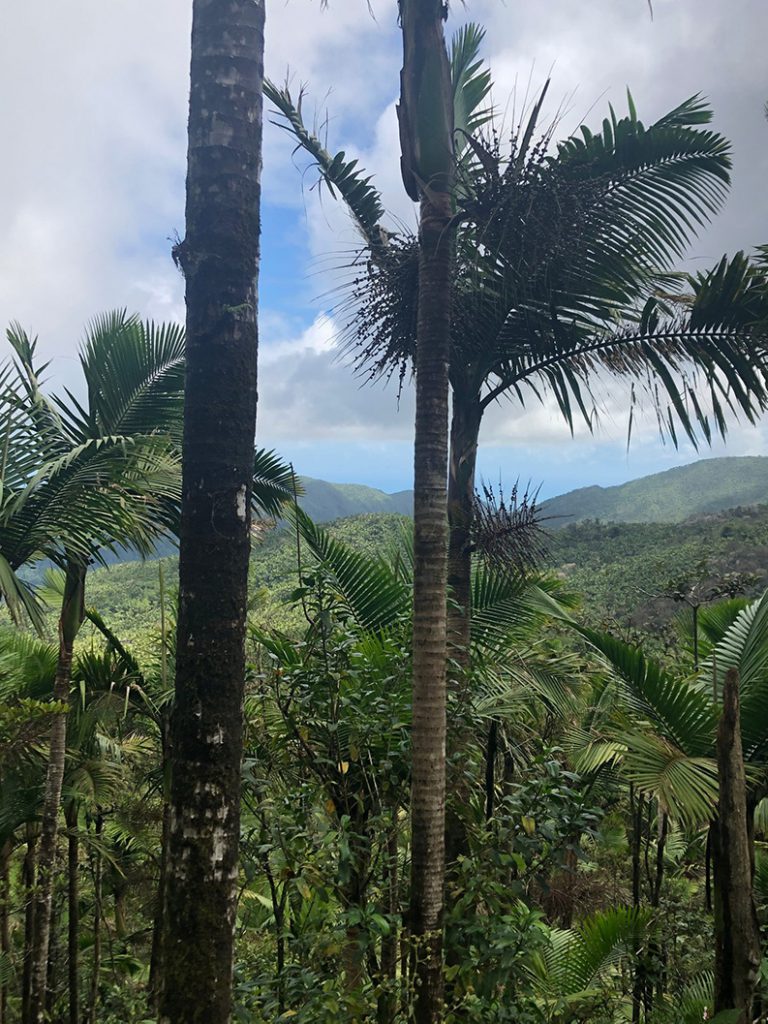
Tsi Tiotonhontsatáhsawe: The Creation Story Project
by Dion Smith-Dokkie
March 28, 2019
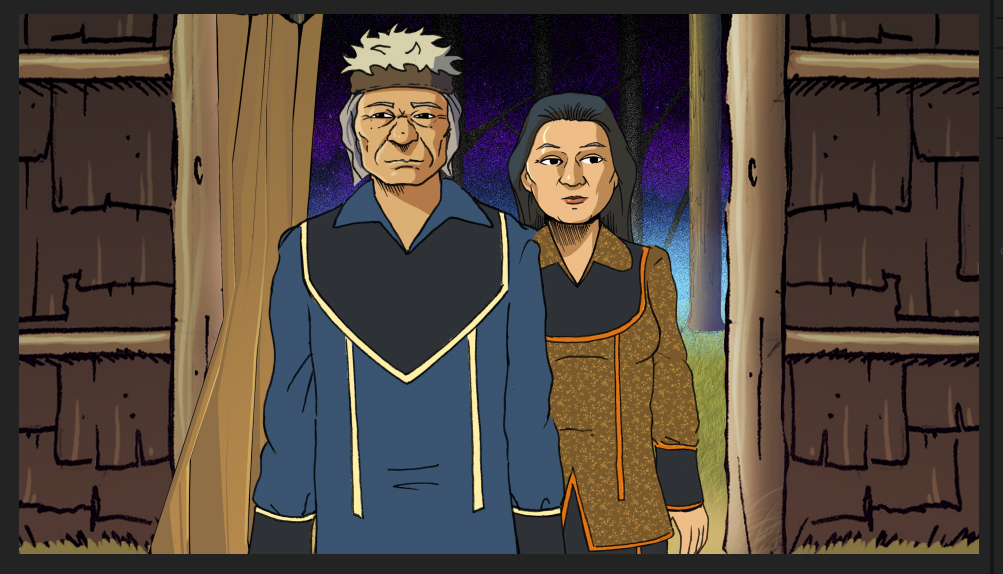
My name is Dion Smith-Dokkie and I’m AbTeC/IIF’s social media coordinator!
For nearly a year, our team has been collaborating with the Kanien’kehá:ka Onkwawén:na Raotitióhkwa Language and Cultural Center (KORLCC). Together, KORLCC and AbTeC/IIF are creating an animated version of the Rotinonhsión:ni (Haudenosaunee/Iroquois) Creation Story in Kanien’kéha (the Mohawk way, i.e. language). The section we are currently working on is expected to be a fully-animated 30 minutes in length and will be the shortest of three sections—in other words, this project is huge!
After months of curious listening and brief updates, I had the chance to sit in on one of our monthly meetings—I was absolutely thrilled! First, some context.
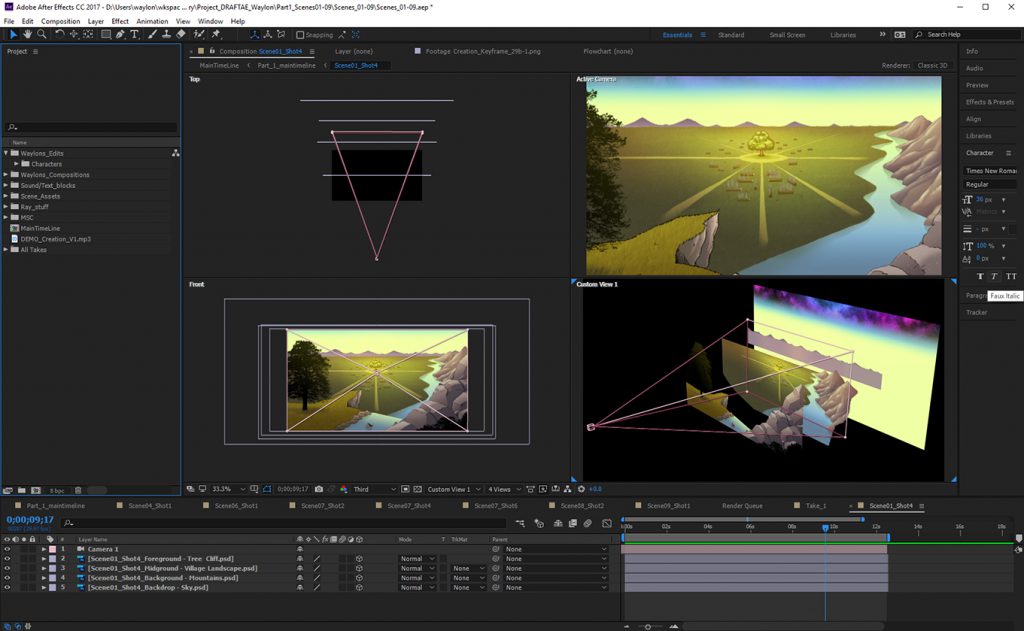
The Initiative for Indigenous Futures has institutional and community-based partners throughout Canada, whom we collaborate with on many great projects. One of our local community partners is the Kanien’kehá:ka Onkwawén:na Raotitióhkwa Language and Cultural Center (KORLCC). Based in Kahnawà:ke Mohawk Territory, which is on the south side of the Kaniatarowanénhne (St. Lawrence River) across from Montreal, KORLCC works to preserve and promote the language and culture of the Mohawks of Kahnawà:ke. We were positively thrilled when KORLCC accepted our invitation to collaborate with them!
We joined the project at the end of the writing phase. KORLCC Curriculum Resource Director Trina Stacey oversees the creation of Kanien’kéha language learning materials, which range from books to audiovisual materials to real-world activities. This animated version of the Tsi Tiotonhontsatáhsawe (the Creation Story, “when the earth began”) in Kanien’kéha will be used as a multimedia language-learning tool!
Trina and KORLCC Graphic Artist and Cultural Liaison, Teiowí:sonte Thomas Deer have spent over a decade developing the script and art for this project. By the time we joined forces, Trina had meticulously combined and adapted a number of oral and written versions of the Tsi Tiotonhontsatáhsawe into a three-part script. Simultaneously, Teiowí:sonte worked with Trina to create concept art for the characters, settings, and scenes described in the script.
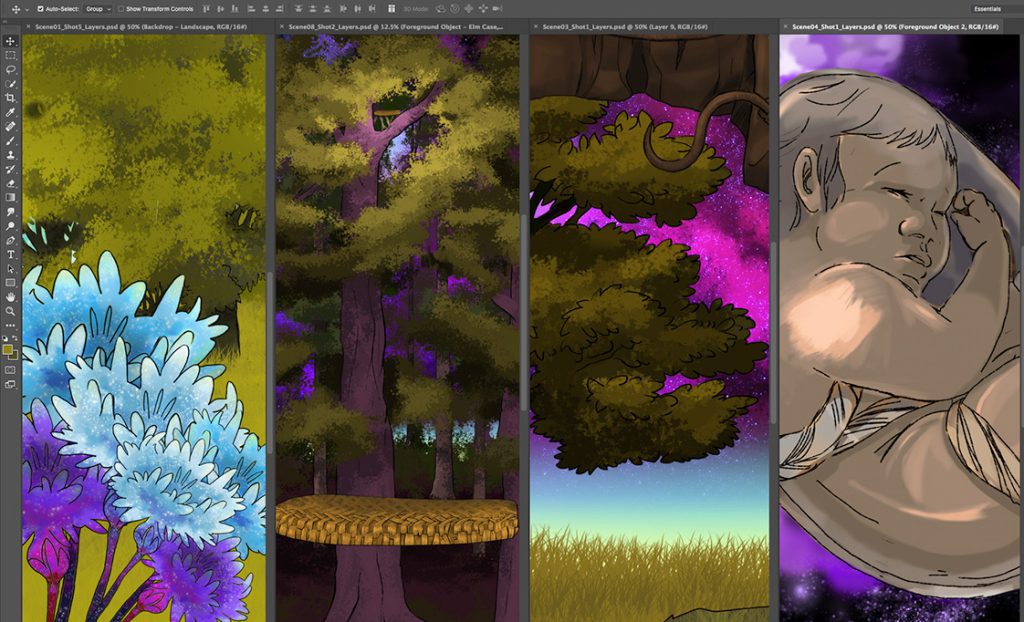
Enter AbTeC/IIF! We’re very proud of our team whose expertise, experimentation, and dedication are making for an electric and exciting process. In her role as IIF Partnership Coordinator and as an artist who has directed her own machinima, Skawennati connects us with KORLCC and, as the project develops, provides advice and feedback. Nancy Elizabeth Townsend is mentoring and assisting Waylon with project management, deadlines and workflow optimization.
Last summer, Research Assistant Kaia’tanó:ron Dumoulin Bush worked with AbTeC/IIF to create an initial version of the animatic—a motion storyboard—for the first installment of the Creation Story. She currently works with Teiowí:sonte to make edits, compile assets, fill in gaps in the original animatic, and prepares the environment of each scene.
Graduate Research Assistant Waylon Wilson is the lead project manager, handling the organizational aspects of the project; he also turns the motion storyboard into an animatic by layering each scene’s image-files, determines camera movements and angles—this way of working is known as 2.5D animation since a number of flat, unique images (assets) create a dynamic, deep space where components can move individually. At this point, the 2.5D animation is ready to get moving! Undergraduate Research Assistant Ray Tqogweg Caplin is the main animator. One of Ray’s most demanding tasks is the creation of character puppets. Ray takes the character artwork and segments the bodies based on where joints are and the range of movement required by each character.
While 2.5D animation is not new, we’re proud to have developed an innovative workflow adapted to the needs of this project. By using Duik 16 (Bassel), a free open-source After Effects plugin, After Effects’s capacity to support puppets has drastically improved. This reduces the number of platforms required to produce the animation and creates reusable, interchangeable character puppets. .
By making space in the workflow for character modification and the reuse of character puppets and animations, our process is streamlined! But let’s not forget about environments and camera movements. The many layers that form each scene are constructed to move in relation to the camera, which creates depth of field (perspective) in the animation. The joint AbTeC/IIF-KORLCC team reviews each final-draft scene together in which they approve the draft or return it for further adjustment.

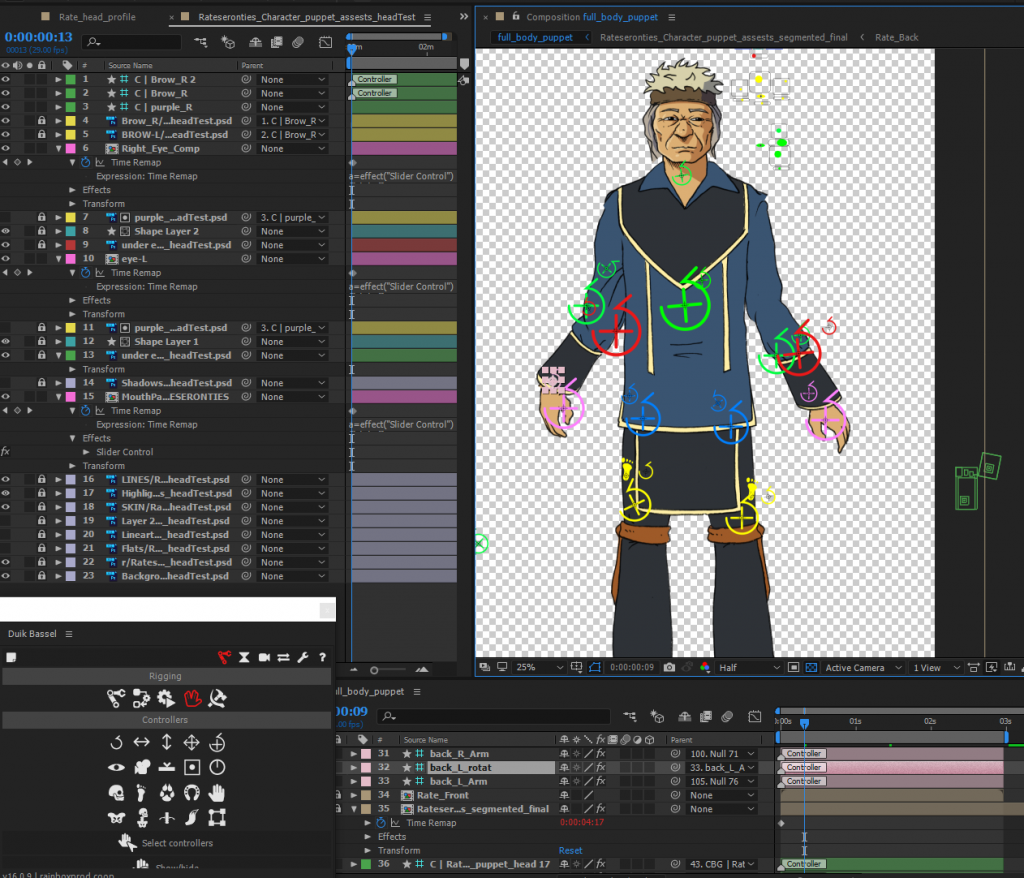
My head was spinning at our most recent meeting. Above all, I was totally absorbed in seeing how the team works together. These meetings create an exciting space where we make the visual elements and Kanien’kéha storytelling resonate with one another.
Scenes must reflect the deeper symbolic meaning of the script. For instance, determining the layout of the village in Karonhià:ke (Sky World) aligns with the responsibility described in the name of Rarón:tote, the Guardian of the Standing Tree.
Our meetings are opportunities to identify inaccuracies. One assumption was that, like on Earth, the sky in Karonhià:ke would also appear blue. This is not true in the context of the Creation Story since the sky, as we know it, appears much later in the narrative. Together, we decided to use a half-twilight, half-galaxy sky to be more faithful to the story.
The team also worked through technical uncertainties. For example, how could we, with our restriction to 2.5D animation, establish 3-point geometric perspective inside of a longhouse? We wanted to avoid the need to re-draw the interior each time we moved the camera. Instead, Ray proposed that we create a 3D rectangular prism in which we could insert existing concept art of the longhouse interior (imagine wallpapering the inside of a virtual box). The scene’s layers, such as the puppets, could then be placed on top of this environment and the camera movements would then create the illusion of dynamic space!
Getting to see the thought process behind certain creative choices was fascinating. The collaboration ensures that deeper meanings and connotations are embedded in the visual elements. With this in mind, it was energizing to think about how the Creation Story shapes and is reflected in the lives of people today.
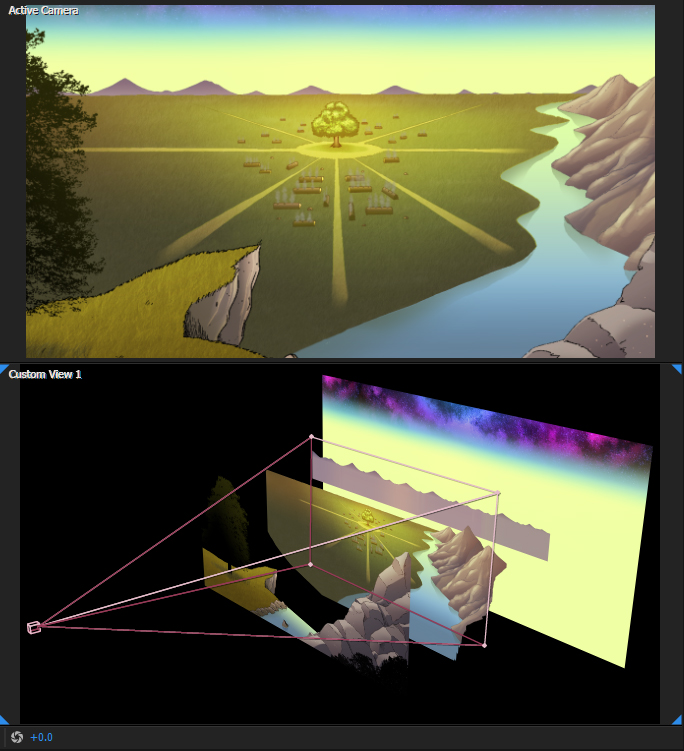
At one point, Trina Stacey explained the deeper meaning of a scene in the story. Rate’seróntie’s (The Uncle) has received a premonition of Iottsi’tsíson (Sky Woman) descending into our world. The premonition is jarring because it shows the Uncle a thought that has never existed before. The Uncle’s dream initiates a sequence of events that will create Turtle Island!
As someone looking in from the outside, I felt a beautiful resonance between this idea in the Creation Story—the idea of how momentous a new way of thinking can be—and the process and purpose of the Tsi Tiotonhontsatáhsawe project: to facilitate Kanien’kéha language learning so that students can see the world in a new way, through the lens of their language.
I would like to thank Skawennati, Nancy Elizabeth Townsend, Sara England, Trina Stacey, and Waylon Wilson for their help in preparing this introduction.
Introducing Jesse Tungilik, IIF + Inuit Futures Artist-in-Residence
by Jesse Tungilik
March 19, 2019

Jesse Tungilik is an Inuit interdisciplinary artist based in Iqaluit, Nunavut. He is primarily interested in conceptual sculpture blending traditional and contemporary materials and themes that explore social and political issues faced by Inuit today. He started his artistic journey as a ceramicist at the Matchbox Gallery in Rankin Inlet, Nunavut at 8 years old and had his first public show of his artwork at a bank lobby in Yellowknife when he was around 11 years old. He has also worked as a jewellery artist under the mentorship of Mathew Nuqingaq at the Aayuraa Studio in Iqaluit.
Jesse spent much of his young adulthood in the civil service working for the newly formed Government of Nunavut where he became an arts administrator eventually becoming the Manager of Cultural Industries for the Government of Nunavut and then the Executive Director of the Nunavut Arts and Crafts Association. He currently is chair of the board of trustees of the Nunatta Sunakkutaangit Museum in Iqaluit and member of the Inuit Leadership Group of the SSHRC grant funded Inuit Futures in Arts Leadership Project.
Many of his conceptual sculptures of late have been inspired by and explore the intersection of government policy and legislation and their adverse impacts on Inuit culture and language, as well as the continued colonization and assimilation of the Inuit into the Canadian body politic. He draws from his experience in government, and from the intergenerational trauma inherited by his father who was an outspoken Residential School survivor to create his art partly as a means to facilitate his own healing and to reconcile his frustrations from working from within and working against government agencies throughout his life.
As Artist-in-Residence at Concordia he will continue his artistic practice focusing on contemporary and conceptual sculpture and design. He has a number of creative projects that he is very excited to pursue while in Montreal.